CHEMICAL RESISTANCE CHART
日本优先评价物质-英文
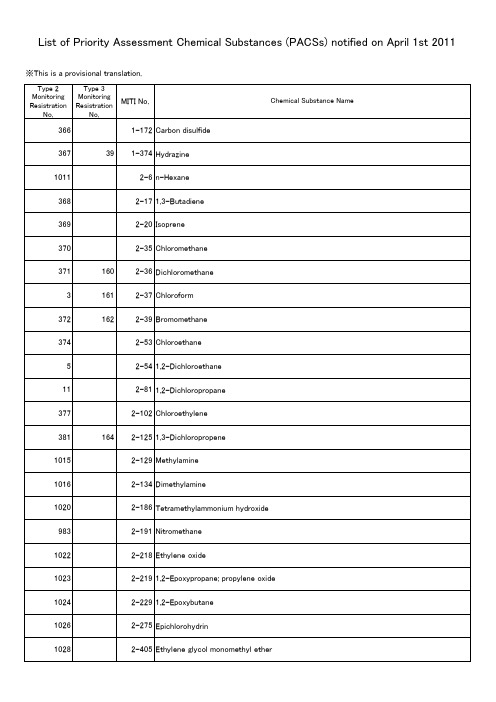
MITI No.
Chemical Substance Name
366 367 1011 368 369 370 371 3 372 374 5 11 377 381 1015 1016 1020 983 1022 1023 1024 1026 1028 164 160 161 162 39
1-172 Carbon disulfide 1-374 Hydrazine 2-6 n-Hexane 2-17 1,3-Butadiene 2-20 Isoprene 2-35 Chloromethane 2-36 Dichloromethane 2-37 Chloroform 2-39 Bromomethane 2-53 Chloroethane 2-54 1,2-Dichloroethane 2-81 1,2-Dichloropropane 2-102 Chloroethylene 2-125 1,3-Dichloropropene 2-129 Methylamine 2-134 Dimethylamine 2-186 Tetramethylammonium hydroxide 2-191 Nitromethane 2-218 Ethylene oxide 2-219 1,2-Epoxypropane; propylene oxide 2-229 1,2-Epoxybutane 2-275 Epichlorohydrin 2-405 Ethylene glycol monomethyl ether
43
7-172 alpha-(Nonylphenyl)-omega-hydroxypoly(oxyethylene)
916
264
7-1279 Polycondensate of 4,4'-isopropylidenediphenol and 1-chloro-2,3-epoxypropane 7-1283 (synonym:bisphenol A type epoxy resin) (liquid)
chemsherpa-ci 成分表
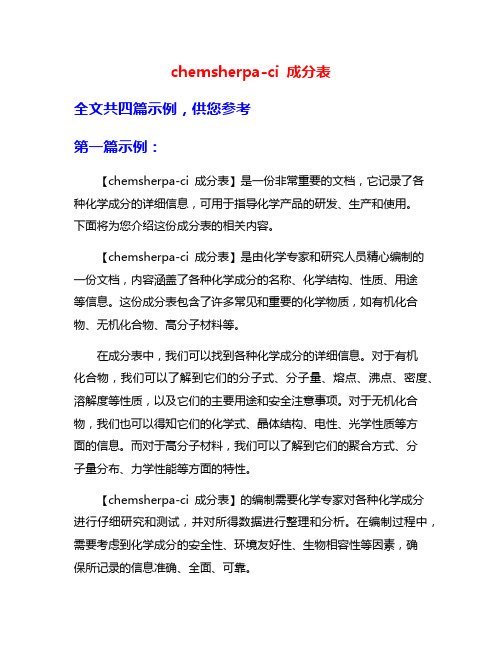
chemsherpa-ci 成分表全文共四篇示例,供您参考第一篇示例:【chemsherpa-ci 成分表】是一份非常重要的文档,它记录了各种化学成分的详细信息,可用于指导化学产品的研发、生产和使用。
下面将为您介绍这份成分表的相关内容。
【chemsherpa-ci 成分表】是由化学专家和研究人员精心编制的一份文档,内容涵盖了各种化学成分的名称、化学结构、性质、用途等信息。
这份成分表包含了许多常见和重要的化学物质,如有机化合物、无机化合物、高分子材料等。
在成分表中,我们可以找到各种化学成分的详细信息。
对于有机化合物,我们可以了解到它们的分子式、分子量、熔点、沸点、密度、溶解度等性质,以及它们的主要用途和安全注意事项。
对于无机化合物,我们也可以得知它们的化学式、晶体结构、电性、光学性质等方面的信息。
而对于高分子材料,我们可以了解到它们的聚合方式、分子量分布、力学性能等方面的特性。
【chemsherpa-ci 成分表】的编制需要化学专家对各种化学成分进行仔细研究和测试,并对所得数据进行整理和分析。
在编制过程中,需要考虑到化学成分的安全性、环境友好性、生物相容性等因素,确保所记录的信息准确、全面、可靠。
对于化学产品的研发和生产,【chemsherpa-ci 成分表】起着非常重要的作用。
生产企业可以通过参考这份成分表了解到不同化学成分的特性,从而选择合适的原材料和生产工艺,确保产品的质量和安全。
企业在生产过程中也可以通过这份成分表了解到各种化学成分的危险特性和防护措施,避免因操作不当而导致的事故和污染。
在化学产品的使用和管理方面,【chemsherpa-ci 成分表】也具有重要的指导作用。
用户可以通过查阅这份成分表了解到化学产品的成分和性质,从而正确使用和储存产品,避免对人体和环境造成危害。
政府监管部门也可以依据这份成分表对化学产品进行分类、管理和监控,保障公众的健康和安全。
【chemsherpa-ci 成分表】是一份不可或缺的重要文档,它不仅对化学研究和生产起着指导作用,也为化学产品的使用和管理提供了强有力的支持。
chemicalcontaminantsinfoodjifsan食品中化学污染物jifsan

Modeling Detected Values
Non-detect values are removed from the data set Detected values are modeled with distributions Probability tree is used to decide which model provides
uncertainty • Food consumption and current practices to address
uncertainty • Conclusions
Uncertainty
The imperfect knowledge concerning the present or future state of an organism, system, or (sub)population under consideration.
Summary statistics used to describe the chemical concentration in foods.
Sources of Uncertainty in Chemical Concentration Data
Sources of uncertainty:
Non-Detects in Chemical Concentration
Current practices for addressing the uncertainty from non-detects:
Substitution Method Modeling Detected Values
Example: Characterization of Summary Statistics with Multiple Distribution Models
石油化工专业英语单词

GlossaryAabsolute permeability 绝对渗透率acentric factor 偏心因子acidic minerals 酸性矿物acidizing fluid formulation 酸液配方acidizing fluid 酸液acid-sensitive minerals 酸敏性矿物acrylamide 丙烯酰胺adhesive forces 附着力advancing contact angles 前进接触角aether 乙醚alkali metals 碱金属alkaline earths 碱土金属alkaline 碱性的,碱的alkali-sensitive minerals 碱敏性矿物aluminum sleeve 铝套筒aluminium silicates 铝硅酸盐aluminosilicate 铝硅酸盐amorphous solids 无定性固体amphiphile 两亲物,亲水脂分子anhydrite 硬石膏anhydrite 无水石膏anhydrite 硬石膏anisotropy 各向异性ankerite 铁白云石ankerite 铁白云石anorthite 钙长石apatite 磷灰石apparent convergence pressure 视收验压力apparent molecular weight 视分子量aragonitic 霰石area-weighted average 面积加权平均aren 芳烃argillaceous cement 泥质胶结arithmetic mean 算术平均aromatic-base crude 芳香基石油aspect ratio 孔喉比asphaltene 沥青质asphaltic-base crude oil 沥青基石油associated gas 伴生气attitude of cementing agent 胶结物产状augmentation 增加,增大,增加物authigenic minerals 自生矿物average curvature radius 平均曲率半径azeotropic liquid 共沸液Bbaculine 棒状的base exchange 阳离子交换base exchange capacity阳离子交换能力Basal cement 基底胶结beds in parallel 并联组合层beds in series 串联组合层benzene 苯bioclastic grainstone 生物屑粒状灰岩biopolymer 生物高聚物,生物聚合物bitumen 沥青black oil reservoir 黑油油藏black oil 黑油bottom hole pressure 井底压力boulder 巨石breccias 角砾岩bridge plug 桥塞brine-sensitive minerals 盐敏性矿物Bryozoans 苔藓虫bubble point 泡点bubble-point pressure 泡点压力bulk volume 外表体积butane 丁烷Ccalcareous cement 钙质胶结calcite 方解石calcium montmorillonite 钙蒙脱石capillary 毛细管, 毛细管的capillary pressure 毛管压力carbazoles 咔唑carbon bisulfide 二硫化碳carbon dichloride二氯化碳carbon tetrachloride四氯化碳casting thin sections 铸体薄片cement slurry 水泥浆cementing agent 胶结物cementation type 胶结类型centipoise 厘泊centrifugal force 离心力centrifuger 离心机centroid 质心CGS system of units 厘米克秒单位制chalky limestone 白垩质石灰岩chamosite 鲕绿泥石characteristics 特性,特征,特点chemical erosion 溶蚀作用chert 燧石chlorite 绿泥石chloroform 氯仿chronological 按年代顺序排列的,依时间前后排列而记载的chronic poisoning急[慢]性中毒clay dilatometer 粘土膨胀仪clay mineral 粘土矿物cleavage 解理cloud point 浊点coalbed methane 煤层甲烷coarse skewed 粗歪度coating material 涂料cobble 粗砾coefficient of isothermal compressibility 等温压缩系数cohesive forces 内聚力colloidal precipitate 胶体沉淀compressibility factor 压缩因子concave 凹的, 凹状condensate gas reservoir, gas condensate reservoir 凝析气藏condensate oil, Condensate 凝析油confining pressure 围压conical 圆锥体的connate water 原生水,同生水connate water saturation 同生水饱和度,封存水饱和度connected porosity 连通孔隙度connectivity of pore 孔隙连通度constant head permeameter 恒压头渗透率仪constant volume depletion test (CVD test) 定容衰竭实验contact angle 接触角contact cement 接触胶结conventional core analysis 常规岩心分析convergence pressure 收验压力convex 凸的,凸状coordination number 孔隙配位数corals 珊瑚虫core flow test 岩心流动试验core holder 岩心夹持器coring barrel 取心筒coring fluid 取心流体screen clothes 筛网cricondenbar 临界凝析压力cricondentherm 临界凝析温度critical gas saturation 临界气饱和度critical loci 临界点轨迹critical point 临界点critical salinity 临界矿化度critical salt concentration 临界盐度critical saturation 临界饱和度cross-section 横截面crystalline layered silicate 结晶层状硅酸盐crystalline layered silicate 结晶层状硅酸盐cyclopentane 环戊烷Ddamage degree of permeability渗透率伤害程度damage rate of permeability 渗透率伤害率Darcy's law 达西定律dead oil 脱气油debris 碎片,残骸,碎屑degassed reservoir 脱气油藏dehydration 脱水作用density contrast 密度差depletion-drive development 衰竭式开发depression 凹陷detrital sediment 碎屑沉积物deviation factor 偏差因子dew point 露点diagenetic processes 成岩过程dichloroethene 二氯乙烷dickite 地开石diesel oil 柴油differentiable function 可微函数dilatometer 膨胀计directional water film 定向水膜displacement 驱替(作用),取代,排出量dissolved gas, solution gas 溶解气distilled water 蒸馏水divalent cation 二价阳离子dolomite 白云石dolomitization 白云石化作用double layer of counterions 双电层理论downhole sampler 井下取样器drilling fluid 钻井液dry gas reservoir 干气藏dry gas 干气dual-porosity medium 双重介质Eeffective porosity 有效孔隙度electrolyte solution 电解质溶液electric stopwatch 电子秒表emulsion 乳状液epoxy pore cast环氧树脂孔隙铸体epoxy paint 环氧树脂涂料envelope curve, binodal curve 双结点曲线equations of state, EOS 状态方程equilateral triangle 等边三角形equilibrium constant, equilibrium ratio 平衡常数equivalence ratio 当量比esters 酯ethane 乙烷ethanol 乙醇ether 石油醚exchange cation 交换阳离子extreme water wettability 亲水性极强extreme water wetting 强水湿extremely high porosity 特高孔隙度extremely low porosity 特低孔隙度Ffatty acids 脂肪酸feldspar sandstone 长石砂岩fenestral pore 窗格状孔隙Fe-rich chlorite 富铁绿泥石fermentation 发酵ferric hydroxide 氢氧化铁ferroan calcite 铁方解石ferruginous matter 铁质fine skewed 细歪度fines migration微粒运移flash equations 闪蒸方程flash liberation 接触分离flocculate 絮凝flocculated state 絮凝状态flow rate 流量flowing porosity 流动孔隙度fluorescence 荧光性fluorhydric acid 氢氟酸fluorin-aluminate 氟铝酸盐fluorosilicate 氟硅酸盐formation compressibility 地层综合压缩系数fracture permeability 裂缝渗透率fracture porosity 裂缝孔隙度Fracture 裂缝free gas 游离气freezing point 凝固点fugacity 逸度full diameter core, 全直径岩心Ggas cap 气顶gas chromatograph 气相色谱gas formation volume factor 天然气体积系数gas saturation 含气饱和度gas-oil ratio 油气比,GORgas-oil transition zone 气油过渡带generatrix 母点,母线,母面geometric-average 几何平均geostatic pressure 地静压力glucan 葡聚糖graduated tube 刻度管grain size grade 粒级grain size 粒度grain-size analysis 粒度分析ground limestone 重质碳酸钙gum 胶质gypsum 石膏Hhalite 岩盐halloysite 多水高岭石harmonic-average 调和平均heat-shrinkable Teflon tube热缩性聚四氟乙烯管heavy oil reservoirs 重质油藏,稠油油藏hematite 赤铁矿heptane 庚烷heptanes plus C7+heterogeneity 非均匀性,非均质性high-pressure metering pump 高压计量泵high pour-point oil 高凝油high-resin crude 高胶原油high-shrinkage crude oil 高收缩原油honeycomb 蜂窝horizontal permeability 水平渗透率hydraulic fracturing 水力压裂hydrocarbon reservoir 油气藏hydrocarbon 碳氢化合物hydrocarbon-lock 烃锁hydrochloric acid 盐酸hydrodynamic condition 水动力条件hydrogen bonds 氢键hydrolyze 水解hydromica 水云母hydrophilic 亲水性的hydrophilic 亲水的hydroxide 氢氧化物hysteresis 滞后(现象)Iigneous rock 火成岩illite 伊利石image acquisition system 图像采集系统immiscible flooding 混相驱immiscible flooding 非混相驱inclined spinning drop tensiometer 倾斜旋滴张力仪inisopiestic retrograde condensation 等压反凝析initial fluid saturation 原始流体饱和度initial formation pressure 原始地层压力injectant 注入剂interconnected pore, conected pore 连通孔隙Intercrystalline pore 晶间孔interfacial curvature 界面曲率interfacial tensiometer 界面张力计interfacial tension force 界面张力intergranular or interparticle 粒间孔隙interstitial-oil saturation隙间油饱和度,残余油饱和度intragranular or intraparticle 粒内孔隙invading fluid 侵入流体iron chelating agent 铁螯合剂irreducible 不可减少的,剩余的,残余的irreducible saturation 不可降低饱和度irreducible water saturation 束缚水饱和度isobars 等压线isobutene 异丁烷isochors 等体积线isolated pore 孤立孔隙isomers 同分异构体isopiestic retrograde region 等压反常区isothermal retrograde region 等温反常区isotherms 等温线isovol, quality line 等液量线Kkerosene 煤油ketones 酮Klinkenberg Effect 可林肯贝克效应,滑脱效应kurtosis 峰态Llaminar flow 层流Law of corresponding states 对应状态原理less-resin crude 低胶原油lead sleeve 铅套筒lieu 场所,代替light oil reservoir 轻质油藏limonite 褐铁矿lipophilic 亲脂性的,亲脂的lipophilic 亲脂性的,脂类的lipophilicity 亲油性logarithmic-average 对数平均low shrinkage oil 低收缩原油lower dew point 下露点lubricating oil 润滑油lubricating oil 润滑油lucite 人造荧光树脂Mmacroscopic 宏观的,肉眼可见的manifold 集管,管汇marl 泥灰岩matrix permeability 基质渗透率matrix porosity 基质孔隙度mean pore diameter 平均孔隙直径mechanical strength 机械强度melting point 熔点meniscus [mi′niskəs] 弯液面,弯月面metabolic 变化的,新陈代谢的metabolite 代谢物metamorphic rocks 变质岩methane 甲烷,沼气methanol 甲醇methyl 甲基micellar 胶束的,微胞的microbial 微生物的,由细菌引起的microcrystalline quartz 微晶石英micro-metering tube 微量计量管microorganism 微生物,微小动植物micropoises 微泊microporosity 次生孔隙度microscopic 微观的,用显微镜可见的minimum miscibility pressure 最小混相压力miscibility experiments 混相实验mixed-base crude 中间基石油mobility 流度moderate wetting 中等润湿moldic pore 印模孔隙monox 氧化硅montmorillonite 蒙脱石movable oil saturation 可动油饱和度mud cake 泥饼muscovite 白云母mutual 相互的、耦合的mutual solubility 互溶性Nnacrite 珍珠陶土nacrite 珍珠陶土naphthenic hydrocarbon 环烷烃naphthenic-base crude oil 环烷基石油near-critical oil reservoir 临界油气藏nemaline 纤维状Newton-Raphson iteration 牛顿-拉夫森迭代NGL recovery, 轻烃回收nodular pore 结核状孔隙non-associated gas 气田气nonpolar 非极性的nontronite 绿高岭石nonuniform 不均匀的,不一致的,不统一的non-uniformity coefficient 不均匀系数normal hexane正己烷normal octane正辛烷North China depression 华北坳陷Ooccurrence 产状off-take potential 产能oil formation volume factor 原油体积系数oil saturation 含油饱和度oil-based mud (OBM) 油基泥浆oil-water transition zone 油水过渡带oil wetting 油湿olefin 烯烃ooids 鲕粒opal 蛋白石opening 孔隙,孔眼order of magnitude 数量级organic fouling 有机垢organic solvent 有机溶剂oriented water film 定向水膜original oil in place OOIP, 原始石油地质储量orthosilicate 正硅酸盐osmotic swelling 渗透水化over saturated reservoir 过饱和油藏overburden pressure 上覆压力oxygen-cleaner 净氧剂ozocerite 地蜡ozocerite 地蜡Ppackstones 泥粒灰岩palaeocurrent 古水流paleogene 第三系paleokarst 古岩溶paraffin hydrocarbon 烷烃paraffin hydrocarbons 芳烃paraffin wax 石蜡paraffine 石蜡paraffinic-naphthenic base crude oils/mixed base crude oil 混合基原油pebble 中砾pendant drop method 悬滴法penetrant method 透过法petralogy analysis 岩石学分析petrochemistry 石油化学petrographic characteristics 岩相学特征phase envelope 相包络区phase transition 相变phase-equilibrium equations 相平衡方程phenols 苯酚photomicrographs 显微照片phyllosilicates 层状硅酸盐plait point 褶点,临界点platy 片状的poises 泊polyacrylamide 聚丙烯酰胺polymer 聚合物polysaccharide 多糖,多聚糖polytetrafluoroethylene (PTFE) 聚四氟乙烯polyvinyl 聚乙烯化合物poor gas 贫气pore cast孔隙铸体pore tortuosity 孔隙迂曲度porous diaphragm device 多孔隔膜仪Porous cement 孔隙胶结porous medium 多孔介质porphyrins 卟啉类化合物porphyritic wettability斑状润湿potassium ion 钾离子pour point 凝点pressolution 压溶作用pressure medium 传压介质primary porosity 原生孔隙度primary water saturation 原生水饱和度process parameters 工艺参数production performance 生产动态prokaryote 原核生物propane 丙烷pseudo component 拟组分pseudo 拟,假,视pseudocritical pressure 拟临界压力pseudocritical temperature 拟临界温度pseudoreduced compressibility 视对比压缩系数pseudoreduced pressure 视对比压力pseudoreduced temperature 视对比温度pseudoternary phase diagram 拟三元相图pulverizer 粉碎机pumice rock 沸石PVT cell PVT筒pyridines 吡啶pyrite 黄铁矿Qquartz sandstone 石英砂岩quinolines 喹啉Rradial permeability 径向渗透率receding contact angles 后退接触角reciprocal-average 倒数平均recrystallization 重结晶作用reduced pressure 对比压力reduced temperature 对比温度reforming 重整relative density 相对密度relative wetting tendencies 相对润湿程度remaining oil saturation 剩余油饱和度reservoir simulation 油藏模拟reservoir space 储集空间reducible water束缚水residual 残余的、剩余的residual oil saturation 残余油饱和度residual water saturation 残余水饱和度resin content 胶质含量resin-asphaltene 胶质-沥青质retention 滞留、保持retort distillation 常压干馏法retrograde 后退,衰退retrograde condensation 等温反凝析retrograde condensation 反凝析retrograde condensation 反凝析作用retrograde vaporization 反蒸发reynolds number 雷诺数rheometer 流变仪rhombohedral arrangement 斜方六面体排列rich gas 富气right angle 直角rock compressibility 岩石压缩系数rock fragment 岩屑roundness 圆度rustless steel 不锈钢Ssalinity 矿化度sample chamber 试样室sampling 取样saponifiable 可皂化的saponite 皂石saturated reservoir 饱和油藏saturation envelope 饱和区相区saturation pressure 饱和压力scaly 鳞状的scanning microscope 扫描电镜schists 片岩scolecite 钙沸石secondary oil production method 二次采油方法secondary porosity 次生孔隙sedimentary environment 沉积环境sedimentary water 沉积水sedimentation method 沉降法semi-permeable baffle funnel 半渗透隔板漏斗sharpness 尖度shrinkage factor 收缩系数, SFshut in 关井siderite 菱铁矿sieve analysis 筛析法siliceous cement 硅质胶结silicon gel 硅凝胶single stage liberation 一次脱气single-porosity medium 单纯介质skeletal allochems 异化颗粒skewness 歪度slippage effect 滑脱效应smectite mixed-layer 蒙皂石混层sodium montmorillonite 钠蒙脱石solitary 孤独的,独立的,单个的,唯一的solubility factor 溶解系数solution cavities 溶洞solution gas-oil ratio 溶解气油比solvent extraction 溶剂抽提法sort 分选,排序sorting coefficient 分选系数sour gas 酸气special core analysis 专项岩心分析speleologist 洞穴学者sphericity 球度spinning drop method 旋转液滴法sponges 海绵动物stage separation 级次分离stagnant pore 死孔隙stainless steel 不锈钢standard deviation 标准偏差stepless speed 无极调速的stepwise iteration 逐步迭代subangular 次棱角形的sulfate-reducing bacteria 硫酸盐还原菌sulfoxides 亚砜supercritical fluid 超临界流体supply radius 供给半径surface hydration 表面水化surface tension表面张力surfactant 表面活性剂susceptibility 感铅性sweet gas 净气swelling capacity 膨润度synergy 协同,协同作用,增效synthetic 合成的,人造的Ttar in oil sands 沥青砂油tar Sand Bitumen 沥青砂油tar sands , bituminous sands 沥青砂teflon tape 聚四氟乙烯带terminal pressure 边界压力ternary phase diagram 三元相图terminal velocity 自由沉降速度tertiary oil recovery 三次采油tertiary system 第三系thermodynamics 经典热力学thickness-weighted average 厚度加权平均tie lines 系线toluene 甲苯total formation volume factor 总体积系数,两相体积系数transformer oil 变压器油transient-well test analysis 瞬态试井分析trial and error method 试算法,迭代法triple-porosity medium 三重介质tubular pore 管状孔隙two-phase region 两相区Uultra-low porosity 特低孔隙度unaided eye 肉眼uncased well-bore无套管井眼unconformities 不整合面unconsolidated core 疏松岩心undersaturated reservoir 未饱和油藏,欠饱和油藏uniform 均匀的,一致的uniformity coefficient 均匀度uniformly 均匀地,无变化地upper dew point 上露点Vvacuumize 造成真空(真空包装,用真空装置弄干) vapor-pressure curve or boiling point curve 蒸汽压线variable head permeameter 变压头渗透率仪velocity sensitivity速敏velocity sensitivity index 速敏指数vernier caliper 游标卡尺vertical permeability 垂直渗透率view volume 视体积viscometer 粘度计viscous crude reservoir 稠油油藏volatile oil reservoir 挥发性油藏volatile oil 挥发油volume-weighted average 体积加权平均vuggy 晶洞Wwater jacket 水套water saturation 含水饱和度water-sensitive minerals 水敏性矿物water sensitivity 水敏water sensitivity index 水敏指数water-soluble 可溶于水的wax content or paraffin content 含蜡量water wetting 水湿weathered detritus 风化碎屑well completion 完井well cuttings 岩屑well-sorted 分选好的wet gas reservoir湿气藏wet gas 湿气wetting hysteresis 润湿滞后Wilhelmy plate method 吊片法workover operations 修井Xxanthan 黄原胶Zzwitterionic 两性离子的21。
混合芳烃材料安全数据表(SHELL MSDS中文翻译)

材料安全数据表(MSDS)混合芳烃版本:第1.5版出具日期:2015年9月16日1. 化学品及企业鉴定1.1. 产品鉴定标识材料名称:混合芳烃化学名称:Naphtha (petroleum), catalytic reformed石脑油(石油)催化重组油化学物质(CAS)登记号:68955-35-1同义字(词):Light Reformate, Heavy Reformate, Reformat, Platformat Combine, Reformat, / Platformat, Reformaat, LPF(Light Powerformate), HPF(Heavy Powerformate)。
轻重整油、重重整油、重整油、高辛烷值汽油整合油等1.2.相关化学物质或混合物鉴别用途和用途建议主要用途分类:工业用途、专业用途特殊用途:燃料、燃料组分、化工原料、其他:见本材料安全数据表后附列表1.3. 本材料安全数据表制造商/供应商信息公司:Shell Eastern Trading (Pte) Ltd(壳牌东方贸易私人有限公司)地址:09 NORTH BUONA VISTA DRIVE#07-01 TOWER 1, THE METROPOLISSINGAPORE, 138588 SINGAPORE电话:+65 6384 80001.4. 紧急联系电话紧急联系电话:+44(0) 151 350 45952. 危害鉴别2.1. 化学物质/混合物分级2.1.1. 根据Regulation(EU)1272/2008分类CLP等级:根据Regulation(EC)1272/2008,该产品被分类为危险品。
Flam. Liq. 1:H224Skin Irrit. 2:H315Muta. 1B:H340Carc. 1B:H350Repr. 2:H361fdSTOT SE 3:H336Asp. Tox. 1:H304Aquatic Chronic 2:H4112.2. 标签元素2.2.1. 根据Regulation(EC)1272/2008标记危险图示:信号词:Danger(危险)危险说明:H224-极易燃液体和蒸汽。
材料学专业名词中英文对译
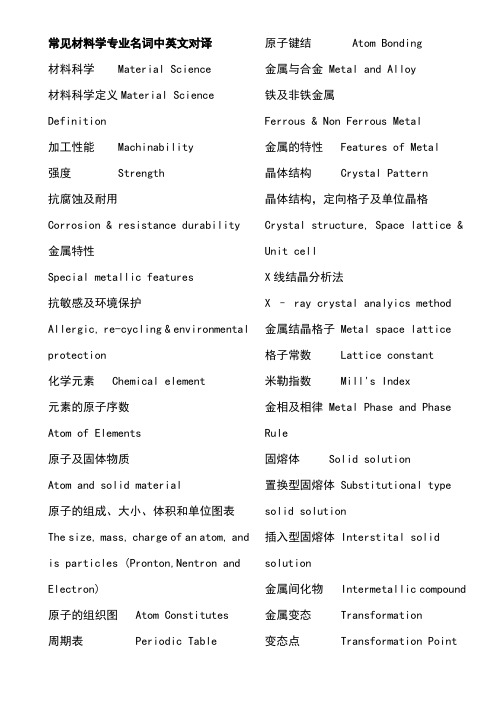
常见材料学专业名词中英文对译材料科学 Material Science材料科学定义Material Science Definition加工性能 Machinability强度 Strength抗腐蚀及耐用Corrosion & resistance durability 金属特性Special metallic features抗敏感及环境保护Allergic, re-cycling & environmental protection化学元素 Chemical element元素的原子序数Atom of Elements原子及固体物质Atom and solid material原子的组成、大小、体积和单位图表The size, mass, charge of an atom, and is particles (Pronton,Nentron and Electron)原子的组织图 Atom Constitutes周期表 Periodic Table 原子键结 Atom Bonding金属与合金 Metal and Alloy铁及非铁金属Ferrous & Non Ferrous Metal金属的特性 Features of Metal晶体结构 Crystal Pattern晶体结构,定向格子及单位晶格Crystal structure, Space lattice & Unit cellX线结晶分析法X – ray crystal analyics method金属结晶格子 Metal space lattice格子常数 Lattice constant米勒指数 Mill's Index金相及相律 Metal Phase and Phase Rule固熔体 Solid solution置换型固熔体 Substitutional type solid solution插入型固熔体 Interstital solid solution金属间化物 Intermetallic compound 金属变态 Transformation变态点 Transformation Point磁性变态 Magnetic Transformation 同素变态 Allotropic Transformation合金平衡状态 Thermal Equilibrium 相律 Phase Rule自由度 Degree of freedom临界温度 Critical temperture共晶 Eutectic包晶温度 Peritectic Temperature包晶反应 Peritectic Reaction包晶合金 Peritectic Alloy亚共晶体 Hypoeutetic Alloy过共晶体 Hyper-ectectic Alloy金属塑性 Plastic Deformation滑动面 Slip Plan畸变 Distortion硬化 Work Hardening退火 Annealing回复柔软 Crystal Recovery再结晶 Recrystallization金属材料的性能及试验Properties & testing of metal化学性能 Chemical Properties物理性能 Physical Properties 颜色 Colour磁性 Magnetisum比电阻Specific resistivity & specific resistance比重Specific gravity & specific density 比热 Specific Heat热膨胀系数Coefficient of thermal expansion 导热度 Heat conductivity机械性能 Mechanical properties屈服强度Yield strength伸长度 Elongation断面缩率 Reduction of area金属材料的试验方法The Method of Metal inspection不破坏检验Non – destructive inspections渗透探伤法 Penetrate inspection 磁粉探伤法Magnetic particle inspection放射线探伤法 Radiographic inspection超声波探伤法 Ultrasonic inspection 显微观察法 Microscopicinspection破坏的检验 DestructiveInspection冲击测试 Impact Test疲劳测试 Fatigue Test潜变测试 Creep Test潜变强度 Creeps Strength第壹潜变期 Primary Creep主要金属元素之物理性质Physical properties of major Metal Elements转变元素 Transition element交换能量 Positive energy exchange外价电子 Outer valence electrons化学结合 Chemical bond钢铁的主要成份The major element of steel钢铁用"碳"之含量来分类Classification of Steel according to Carbon contents 铁相 Steel Phases钢铁的名称 Name of steel纯铁体 Ferrite渗碳体 Cementitle奥氏体 Austenite珠光体及共释钢 Pearlite &Eutectoid 奥氏体碳钢 Austenite Carbon Steel 单相金属 Single Phase Metal共释变态 Eutectoid Transformation珠光体 Pearlite过共释钢 Hype-eutectoid珠光体 Pearlite粗珠光体 Coarse pearlite中珠光体 Medium pearlite幼珠光体 Fine pearlite磁性变态点 Magnetic Transformation 钢铁的制造 Manufacturing of Steel 连续铸造法 Continuous casting process电炉 Electric furnace钢铁生产流程 Steel Production Flow Chart钢材的熔铸、锻造、挤压及延轧The Casting, Fogging, Extrusion, Rolling & Steel熔铸 Casting锻造 Fogging挤压 Extrusion延轧 Rolling冲剪 Drawing & stamping特殊钢 Special Steel简介 General特殊钢以原素分类Classification of Special Steel according to Element特殊钢以用途来分类Classification of Special Steel according to End UsageSulphuric Free Cutting Steel硬化性能 Hardenability钢的脆性 Brittleness of Steel 低温脆性 Cold brittleness回火脆性 Temper brittleness 材料的加工性能 Drawing abillity 硬度 Hardness表面处理 Surface finish End usages, industrial standard, quality, condition and hardness of cold rolled steel strip硬度及拉力 Hardness & Tensile strength test拉伸测试(顺纹测试) Elongation test 曲面(假曲率) Camber防止生锈 Rust Protection生锈速度表 Speed of rusting焊接 Welding气焊 Gas Welding埋弧焊 Submerged-arc Welding电阻焊 Resistance Welding电解/电镀锌大大增强钢片的防锈能力Galvanic Action improving Weather & Corrosion Resistance of the Base Steel Sheet上漆能力 Paint Adhesion电镀锌钢片的焊接Welding of Electro-galvanized steel sheet点焊 Spot welding滚焊 Seam welding电镀锌(电解)钢片Electro-galvanized Steel Sheet生产流程 Production Flow Chart锌镀层质量 Zinc Coating Mass表面处理 Surface Treatment冷轧钢片 Cold-Rolled SteelSheet/Strip热轧钢片 Hot-Rolled Sheet/Strip电解冷轧钢片厚度公差Thickness Tolerance of Electrolytic Cold-rolled sheet热轧钢片厚度公差Thickness Tolerance of Hot-rolled sheet冷轧或热轧钢片阔度公差 Width Tolerance of Cold or Hot-rolled sheet 长度公差 Length Tolerance理论质量 Theoretical Mass简介 General硬度 Hardness钢的种类 Type of Steel表面处理 Surface Finish常用尺寸 Commonly Used Size 电器用硅 [硅] 钢片 Electrical Steel Sheet软磁材料 Soft Magnetic Material硬磁材料 Hard Magnetic Material最大能量积 Maximum Energy Product 晶粒取向(Grain-Oriented)及非晶粒取向(Non-Oriented)Grain Oriented & Non-Oriented电器用硅 [硅] 钢片的最终用途及规格End Usage and Designations of Electrical Steel Strip电器用的硅 [硅] 钢片之分类Classification of Silicon Steel Sheet for Electrical Use电器用钢片的绝缘涂层Performance of Surface Insulation of Electrical Steel Sheets退火Annealing电器用钢片用家需自行应力退火原因Annealing of the Electrical Steel Sheet退火时注意事项 Annealing Precautionary提防过份氧化 No Excessive Oxidation应力退火温度Stress –relieving Annealing Temperature绝缘表面 Surface Insulation镀铝硅合金钢片的特色Feature of Aluminized Silicon Alloy Steel Sheet用途 End Usages抗化学品能力 Chemical Resistance 公差 Size Tolerance焊接能力 Weldability钢板 Steel Plate钢板用途分类及各国钢板的工业标准包括日工标准及美材试标准Type of steel Plate & Related JIS, ASTM and Other Major Industrial Standards钢板生产流程 Production Flow Chart 钢板订货需知 Ordering of Steel Plate不锈钢 Stainless Steel不锈钢的定义Definition of Stainless Steel不锈钢之分类,耐腐蚀性及耐热性Classification, Corrosion Resistant & Heat Resistance of Stainless Steel 铁铬系不锈钢片Chrome Stainless Steel表面处理 Surface finish不锈钢片机械性能(301, 304, 631, CSP) Mechanical Properties of Spring use Stainless Steel不锈钢–种类,工业标准,化学成份,特点及主要用途Stainless Steel – Type, Industrial Standard, Chemical Composition, Characteristic & end usage of the most commonly used Stainless Steel 不锈钢薄片用途例End Usage of Thinner Gauge不锈钢片、板用途例Examples of End Usages of Strip, Sheet & Plate不锈钢应力退火卷片常用规格名词图解General Specification of Tension Annealed Stainless Steel Strips耐热不锈钢Heat-Resistance Stainless Steel 镍铬系耐热不锈钢特性、化学成份、及操作温度Heat-Resistance Stainless Steel 铬系耐热钢Chrome Heat Resistance Steel镍铬耐热钢Ni - Cr Heat Resistance Steel超耐热钢Special Heat Resistance Steel抗热超级合金Heat Resistance Super Alloy边缘处理 Edge Finish硬度 Hardness高碳钢化学成份及用途高碳钢片 High Carbon Steel Strip 分类 Classification用组织结构分类 Classification According to Grain Structure用含碳量分类–即低碳钢、中碳钢及高碳钢 Classification According to Carbon Contains弹簧用碳钢片CarbonSteel Strip For Spring Use 冷轧状态 Cold Rolled Strip回火状态 Annealed Strip淬火及回火状态Hardened & Tempered Strip/ Precision – Quenched Steel Strip贝氏体钢片 Bainite Steel Strip弹簧用碳钢片材之边缘处理 Edge Finished淬火剂 Quenching Media碳钢回火 Tempering回火有低温回火及高温回火Low & High Temperature Tempering 高温回火High Temperature Tempering退火 Annealing完全退火 Full Annealing扩散退火 Diffusion Annealing低温退火 Low Temperature Annealing 中途退火 Process Annealing球化退火 Spheroidizing Annealing光辉退火 Bright Annealing淬火 Quenching时间淬火 Time Quenching奥氏铁孻回火 Austempering马氏铁体淬火 Marquenching高碳钢片用途 End Usage of High Carbon Steel Strip冷轧高碳钢–日本工业标准Cold-Rolled (Special Steel) Carbon Steel Strip to JIS G3311电镀金属钢片 Plate Metal Strip电镀金属捆片的优点Advantage of Using Plate Metal Strip 金属捆片电镀层Plated Layer of Plated Metal Strip 镀镍 Nickel Plated镀铬 Chrome Plated镀黄铜 Brass Plated基层金属 Base Metal of Plated Metal Strip低碳钢或铁基层金属Iron & Low Carbon as Base Metal不锈钢基层金属 Stainless Steel as Base Metal铜基层金属 Copper as Base Metal 黄铜基层金属 Brass as Base Metal 轴承合金 Bearing Alloy易溶合金 Fusible Alloy化学成份 Chemical Composition机械性能 Mechanical Properties化学成份 Chemical composition Manufacturing Method应用材料 Material Used特点 Characteristic用途 End Usages材料的类型Types of materials, metals, ceramics, polymers, composites, elastomer部分材料性质复习Review of selected properties of materials,电导率和电阻率conductivity and resistivity,热导率thermal conductivity,应力和应变stress and strain,弹性应变elastic strain,塑性应变plastic strain,屈服强度yield strength,最大抗拉强度ultimate tensile strength,最大强度ultimate strength,延展性ductility,伸长率elongation,断面收缩率reduction of area,颈缩necking,断裂强度breaking strength,韧性toughness,硬度hardness,疲劳强度fatigue strength,蜂窝 honeycomb,热脆性 heat shortness,晶胞中的原子数atoms per cell,点阵lattice, 阵点lattice point, 点阵参数lattice parameter,密排六方hexagonal close-packed, 六方晶胞hexagonal unit cell,体心立方body-centered cubic,面心立方face-centered cubic,弥勒指数Miller indices,晶面crystal plane,晶系crystal system,晶向crystal direction,相变机理Phase transformation mechanism: 成核生长相变nucleation–growth transition,斯宾那多分解spinodal decomposition,有序无序转变disordered-order transition,马氏体相变martensite phase transformation,成核nucleation,成核机理nucleation mechanism,成核势垒nucleation barrier,晶核,结晶中心nucleus of crystal, 金属组织的)基体quay,基体,基块,基质,结合剂matrix, 子晶,雏晶matted crystal,耔晶,晶种seed crystal,耔晶取向seed orientation,籽晶生长seeded growth,均质核化homogeneous nucleation, 异质核化heterogeneous nucleation, 均匀化热处理homogenization heat treatment,熟料 grog,自恰场self-consistent field固溶体Solid solution:有序固溶体ordered solid solution, 无序固溶体disordered solid solution,有序合金ordered alloy,无序合金disordered alloy.无序点阵disordered lattice,分散,扩散,弥散dispersal,分散剂dispersant,分散剂,添加剂dispersant additive, 分散剂,弥散剂dispersant agent缺陷defect, imperfection,点缺陷point defect,线缺陷 line defect, dislocation,面缺陷interface defect, surface defect,体缺陷volume defect,位错排列dislocation arrangement, 位错阵列dislocation array,位错气团dislocation atmosphere,位错轴dislocation axis,位错胞dislocation cell,位错爬移dislocation climb, 位错滑移dislocation slip, dislocation movement by slip,位错聚结dislocation coalescence, 位错核心能量dislocation core energy,位错裂纹dislocation crack,位错阻尼dislocation damping,位错密度dislocation density,体积膨胀volume dilation,体积收缩volume shrinkage,回火tempering,退火annealing,退火的,软化的softened,软化退火,软化(处理)softening, 淬火quenching,淬火硬化quenching hardening,正火normalizing, normalization, 退火织构annealing texture,人工时效artificial aging,细长比aspect ratio,形变热处理ausforming,等温退火austempering,奥氏体austenite,奥氏体化austenitizing,贝氏体bainite,马氏体martensite,马氏体淬火marquench,马氏体退火martemper,马氏体时效钢maraging steel,渗碳体cementite,固溶强化solid solution strengthening,钢屑混凝土steel chips concrete,水玻璃,硅酸钠sodium silicate,水玻璃粘结剂sodium silicate binder, 硅酸钠类防水剂sodium silicate waterproofing agent,扩散diffusion,扩散系数diffusivity,相变phase transition,烧结sintering,固相反应solid-phase reaction,相图与相结构phase diagrams and phase structures ,相phase,组分component,自由度freedom,相平衡phase equilibrium, 吉布斯相律Gibbs phase rule,吉布斯自由能Gibbs free energy,吉布斯混合能Gibbs energy of mixing, 吉布斯熵Gibbs entropy,吉布斯函数Gibbs function,相平衡phase balance,相界phase boundary,相界线 phase boundary line,相界交联 phase boundary crosslinking,相界有限交联phase boundary crosslinking,相界反应phase boundary reaction, 相变phase change,相组成phase composition,共格相 phase-coherent,金相相组织 phase constentuent,相分布phase distribution,相平衡常数phase equilibrium constant,相平衡图phase equilibrium diagram, 相分离phase segregation, phase separation,玻璃分相phase separation in glasses,相序phase order, phase sequence, 相稳定性phase stability,相态phase state,相稳定区phase stabile range,相变温度phase transition temperature,相变压力phase transition pressure, 同质多晶转变polymorphic transformation,相平衡条件phase equilibrium conditions,显微结构microstructures,不混溶固溶体immiscible solid solution,转熔型固溶体peritectic solid solution,低共熔体eutectoid,crystallization, 不混溶性immiscibility,固态反应solid state reaction,烧结sintering,相变机理Phase transformation mechanism: 成核生长相变nucleation–growth transition,斯宾那多分解spinodal decomposition,有序无序转变disordered-order transition,马氏体相变martensite phase transformation,成核nucleation,成核机理nucleation mechanism,成核势垒nucleation barrier,晶核,结晶中心nucleus of crystal, (金属组织的)基体quay,基体,基块,基质,结合剂matrix, 子晶,雏晶matted crystal,耔晶,晶种seed crystal,耔晶取向seed orientation,籽晶生长seeded growth,均质核化homogeneous nucleation, 异质核化heterogeneous nucleation, 均匀化热处理homogenization heat treatment。
气动隔膜泵化学对照表
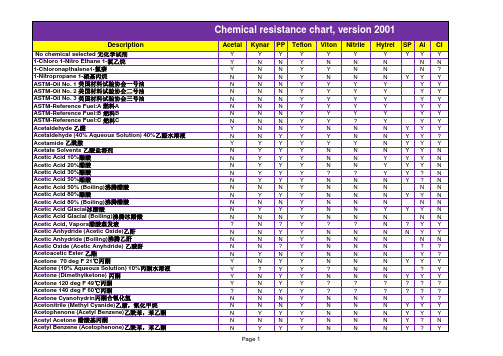
Description
No chemical selected 无化学试剂 1-Chloro 1-Nitro Ethane 1-氯乙烷 1-Chloronapthalene1-氯萘 1-Nitropropane 1-硝基丙烷 ASTM-Oil No. 1 美国材料试验协会一号油 ASTM-Oil No. 2 美国材料试验协会二号油 ASTM-Oil No. 3 美国材料试验协会三号油 ASTM-Reference Fuel:A 燃料A ASTM-Reference Fuel:B 燃料B ASTM-Reference Fuel:C 燃料C Acetaldehyde 乙醛 Acetaldehyde (40% Aqueous Solution) 40%乙醛水溶液 Acetamide 乙酰胺 Acetate Solvents 乙酸盐溶剂 Acetic Acid 10%醋酸 Acetic Acid 20%醋酸 Acetic Acid 30%醋酸 Acetic Acid 50%醋酸 Acetic Acid 50% (Boiling)沸腾醋酸 Acetic Acid 80%醋酸 Acetic Acid 80% (Boiling)沸腾醋酸 Acetic Acid Glacial冰醋酸 Acetic Acid Glacial (Boiling)沸腾冰醋酸 Acetic Acid, Vapors醋酸蒸发液 Acetic Anhydride (Acetic Oxide)乙酐 Acetic Anhydride (Boiling)沸腾乙酐 Acetic Oxide (Acetic Anyhdride) 乙酸酐 Acetoacetic Ester 乙酯 Acetone 70 deg F 21℃丙酮 Acetone (10% Aqueous Solution) 10%丙酮水溶液 Acetone (Dimethylketone) 丙酮 Acetone 120 deg F 49℃丙酮 Acetone 140 deg F 60℃丙酮 Acetone Cyanohydrin丙酮合氰化氢 Acetonitrile (Methyl Cyanide)乙腈,氰化甲烷 Acetophenone (Acetyl Benzene)乙酰苯,苯乙酮 Acetyl Acetone 醋酸基丙酮
chemical resistance guide 全
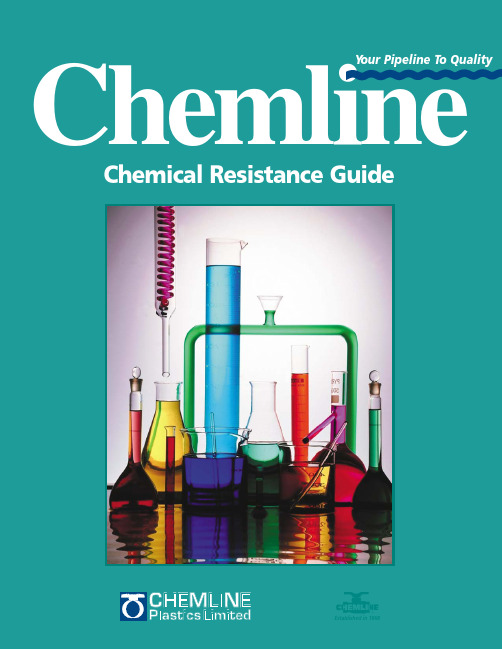
Established in 1968ThermoplasticsPVC (Polyvinyl Chloride)The most economical and largest selection of Chemline valves are moulded from PVC. It offers excellent mechanical and chemical resistance properties at low cost. The working temperature range of PVC valves is 0 to 60°C (30 to 140°F). PVC used for Chemline valves is identified by cell classification number 11564-A as per ASTM Standard D 1784. The suffix “A” refers to the highest chemical resistance rating. Most other PVC valves as well as pipe and fittings have only a “B” chemical resistance rating.The special PVC “A” compound used in Chemline valves resists attack of most acids, strong alkalais, salts and many other chemicals. High chemical resistance of this material allows its application on aggressive services such as 98%H2SO4, dry chlorine and low pressure wet chlorine gas. PVC is attacked by chlorinated hydrocarbons, ketones, esters and some aromatic compounds. It can be used on solutions containing up to 1000 ppm solvents.Chemline PVC valves are non-toxic. They meet CSA standard B137.0 for toxicity.They are resistant to damaging effects of sunlight and weathering, thus painting is not necessary.CPVC (Chlorinated Polyvinyl Chloride)CPVC is very similar to PVC in mechanical properties and chemical resistance. It is suitable for applications from0 to 95°C (30 to 200°F).The special CPVC compound used for Chemline valves is classified as 23567-A as per ASTM D 1784. The suffix “A”denotes conformance to the highest chemical resistance rating. The compound is non-toxic, conforming to CSA toxicity standard B137.0.CPVC valves have proven to be an excellent choice for applications at temperatures too high for PVC or when an extra margin of safety is required.PP(Polypropylene)PP is light weight and high in chemical resistance. Valves are suitable for service from -20 to 90°C (-5° to 195°F). PP is unaffected by alkalais, salts, organic solvents and most acids, particularly hydrochloric and phosphoric acid. It is unsuitable on strong acids, chlorinated hydrocarbons, aromatic compounds and high concentrations of free chlorine.PP is very inert thus popular for high purity applications such as deionized water, etc. The material comes normally opaqued by addition of grey-beige pigment to prevent ultraviolet light penetration. Natural translucent material without pigment will degrade if exposed to UV light (sun light). Chemline offers PP pipe, fittings and valves in pigmented and unpigmented PP, both approved by the FDA for contact with food.PVDF(Polyvinylidene Fluoride)PVDF is superior to other valve thermoplastics in chemical resistance and abrasion resistance. It has remarkable strength over the largest working temperature range. The working temperature range of PVDF valves is -40 to 120°C (-40 to 250°F).PVDF’s impact strength is over twice that of PVC. The valves are extremely durable under mechanical abuse even at -40°F. They also offer the highest abrasion resistance of thermoplastic valves.PVDF has excellent chemical resistance against halogens such as chlorine and bromine, strong acids such as hydrofluoric and nitric acids, organic solvents and oils. PVDF is not resistant to hot bases.It is also non toxic and imparts no odours or tastes into the fluid. Our PVDF conforms with USDA Title 21, P121.2593 requirements for contact with food.Gas permeability of PVDF is extremely low. A patented PVDF gas permeability barrier is available on Type 14 and DV Series Diaphragm Valves.It is a backing to the Teflon®diaphragm and has proven to increase the life of diaphragm valves on chlorine and strong acid services.T eflon®PTFE (Polytetrafluoroethylene)PTFE is almost totally insoluble and chemically inert. It has high temperature resistance. Teflon®PTFE ball seats, because of natural lubricity, require no lubrication. Teflon®PTFE diaphragms and flange gaskets are used in the most severe chemical resistance applications.ElastomersEPDM (Ethylene Propylene T erpolymer)EPDM is a synthetic rubber used as the standard seal material for most Chemline valves. It is the most economical choice of elastomer and has excellent chemical resistance on the great majority of applications including acids, alkalais, salts and many others at temperatures up to 90°C. EPDM is weak on organic compounds and cannot be used on oils and fats. Chemline valves seals of EPDM meet CSA standard B137.0 for non-toxicity.Viton®(Fluorocarbon Rubber, abv. FPM)Viton®is more expensive than EPDM so is used as an alternate elastomer when required. It has excellent resistance to mineral acids, oils and many aliphatic and aromatic hydrocarbons. Viton®is weak on sodium hydroxide. CPE (Chlorinated Polyethylene)CPE is superior to all other elastomers on sodium hypochlorite. It resists hypochlorite up to full strength (13%). Ball valves supplied with CPE seals are very price competitive on this service.NITRILE (Acrylonitrile-Butadiene Copolymer, abv. NBR) Nitrile is also know as Buna-N. It has high chemical resistance to oil and petroleums but is weak on oxidizing media i.e. acids. Nitrile has excellent abrasion resistance and is less expensive than Viton®for butterfly valve seats.Materials ofConstructionYour Pipeline to Quality©Chemline Plastics Limited 2001ChemicalYour Pipeline to Quality1*30% Ammonia solution at 50ºC, PVC & EPDM recommended. 2Your Pipeline to QualityYour Pipeline to Quality34Your Pipeline to QualityOHC(CHYour Pipeline to Quality56Your Pipeline to QualityYour Pipeline to Quality7PVC or CPVC material bodies are recommended for maximum 21 psi services. Consult Chemline on all chlorine gas applications.*Special Viton FPM-C required. Consult Chemline.8Your Pipeline to QualityYour Pipeline to Quality9Epsom Salts- See Magnesium Sulfate, page 15. 10Your Pipeline to QualityYour Pipeline to Quality11*For Premium grade Gasoline,a special Buna-N elastomer isrecommended over Viton. Consult Chemline.12Your Pipeline to QualityYour Pipeline to Quality13*Hydrochloric Acid:20° Baumé = 32%; 23° Baumé (Fuming) = 38% concentration.**Hydrogen Peroxide:35% at 55°C Viton = “A”; 40% at 66°C Viton = “B”.Hydrofluorosilicic Acid -See Fluorosilicic Acid, page 11.14Your Pipeline to QualityYour Pipeline to Quality1516Your Pipeline to QualityYour Pipeline to Quality17Valves are used on nitric acid , the PVDF Gas Barrier is always recommended if a Teflon diaphragm.18Your Pipeline to QualityYour Pipeline to Quality1920Your Pipeline to QualityYour Pipeline to Quality2122Your Pipeline to QualityYour Pipeline to Quality2324Your Pipeline to Quality*Moulded PVDF material is suitable for Sodium Hypochlorite;however, fusion welded joints may fail prematurely.Sulfuric Acid at 90°C: up to 50% – PP rated “A”, EPDM rated “B”; 51-93% – PP rated “C”.Your Pipeline to Quality25Sulfuric Acid at 90°C: up to 50% – PP rated “A”, EPDM rated “B”; 51-93% – PP rated “C”.*66 Baumé Sulphuric Acid = 96% concentration.26Your Pipeline to QualityYour Pipeline to Quality2728Your Pipeline to QualityYour Pipeline to Quality29FDA requirements for contact with food.High Corrosion Resistance – Chemline valves will stand up to many aggressive chemical services where expensive alloy metals fail.They are designed to withstand corrosive atmosphere. No Lining Problems –Bodies and discs are solid Advantages of Chemline SolidThermoplastic Valves and ControlsPiping, Flow Meters and Controls55 Guardsman Road, Thornhill, Ontario, Canada, L3T 6L2Tel:(905) 889-7890Sales:(905) 889-7021Fax:(905) 889-8553email:info@ CRG301©Chemline Plastics Limited 2001This 6” polypropylene butterfly valve is on wet sulphur dioxide gas up to 140°F in a paper mill in Ontario. It wasinstalled in July 1979 to replace a much higher priced special alloy butterfly valve .This Chemline butterfly valve complete with P Seriespneumatic actuator has been in service since 1985. It is on a wastewater line at an Ontario rendering plant. External corrosion is severe due to an ammonia atmosphere.。
Chemical Compatibility
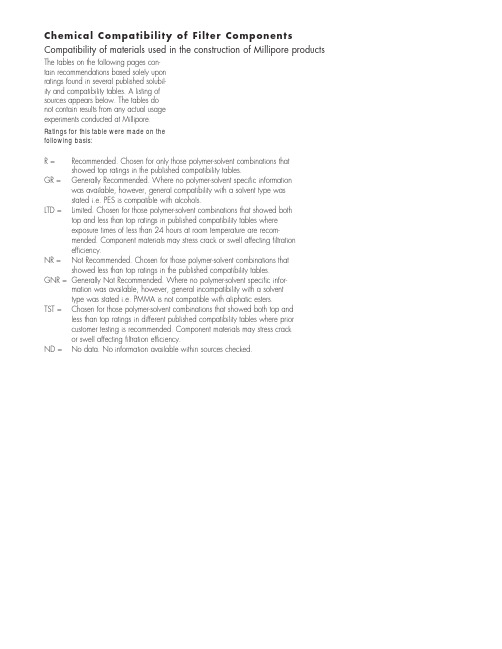
References used in developing this table
1) Polymer Handbook, ed III., Section VII p. 379-402 lists solvents and nonsolvents for a variety of polymers 2) Organic Polymer Chemistry, 2nd edition, K.J.Saunders, Chapman & Hall, 1988. 3) Appropriate sections in Encyclopedia of Polymer Science and Engineering 4) Chemical Resistance Guide for Elastomers, Compass Publications Kenneth M.Pruett, 1988. 5) Compass Corrosion Guide II, Compass Publications Kenneth M.Pruett, 1983. 6) /nfvitongrades.html (Compatibility Viton) 7) /nfmaterials.html (Compatibility of O-ring materials) 8) t.hk/sepo/tips/ch/ch004.htm (General polymer compatibility) 9) /eltypes.htm (elastomer properties) 10) Merck Index, 10th edition 11) Chapiro, Mankowski & Schmitt, J.Polymer Science: Chemistry edition, Vol.20, 1982, p. 1791-1796 12) Bottino, Capannelli, Munari & Turturro, J.Polymer Science: Polymer Physics, Vol 26, 1988, p. 785-94. 13) CRC Handbook of Polymer-Liquid Interaction Parameters and Solubility Parameters, Allan F.M. Barton, CRC Press, 1990.
材料加工专业英语词汇
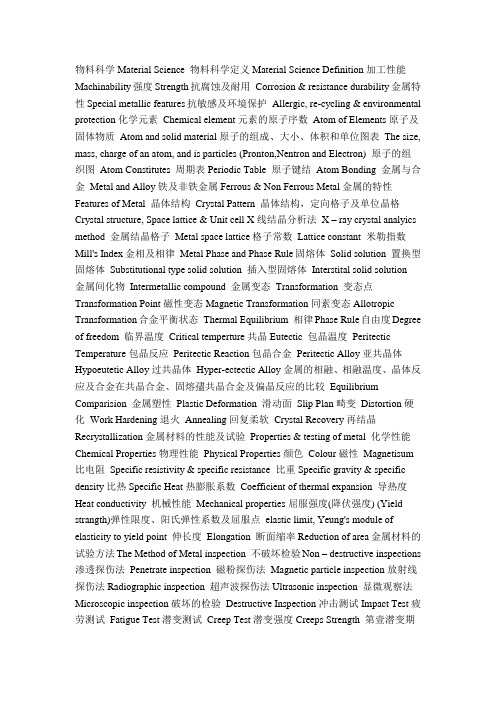
物料科学Material Science 物料科学定义Material Science Definition加工性能Machinability强度Strength抗腐蚀及耐用Corrosion & resistance durability金属特性Special metallic features抗敏感及环境保护Allergic, re-cycling & environmental protection化学元素Chemical element元素的原子序数Atom of Elements原子及固体物质Atom and solid material原子的组成、大小、体积和单位图表The size, mass, charge of an atom, and is particles (Pronton,Nentron and Electron) 原子的组织图Atom Constitutes 周期表Periodic Table 原子键结Atom Bonding 金属与合金Metal and Alloy铁及非铁金属Ferrous & Non Ferrous Metal金属的特性Features of Metal 晶体结构Crystal Pattern 晶体结构,定向格子及单位晶格Crystal structure, Space lattice & Unit cell X线结晶分析法X – ray crystal analyics method 金属结晶格子Metal space lattice格子常数Lattice constant 米勒指数Mill's Index金相及相律Metal Phase and Phase Rule固熔体Solid solution 置换型固熔体Substitutional type solid solution 插入型固熔体Interstital solid solution金属间化物Intermetallic compound 金属变态Transformation 变态点Transformation Point磁性变态Magnetic Transformation同素变态Allotropic Transformation合金平衡状态Thermal Equilibrium 相律Phase Rule自由度Degree of freedom 临界温度Critical temperture共晶Eutectic 包晶温度Peritectic Temperature包晶反应Peritectic Reaction包晶合金Peritectic Alloy亚共晶体Hypoeutetic Alloy过共晶体Hyper-ectectic Alloy金属的相融、相融温度、晶体反应及合金在共晶合金、固熔孻共晶合金及偏晶反应的比较Equilibrium Comparision 金属塑性Plastic Deformation 滑动面Slip Plan畸变Distortion硬化Work Hardening退火Annealing回复柔软Crystal Recovery再结晶Recrystallization金属材料的性能及试验Properties & testing of metal 化学性能Chemical Properties物理性能Physical Properties颜色Colour磁性Magnetisum 比电阻Specific resistivity & specific resistance 比重Specific gravity & specific density比热Specific Heat热膨胀系数Coefficient of thermal expansion 导热度Heat conductivity 机械性能Mechanical properties屈服强度(降伏强度) (Yield strangth)弹性限度、阳氏弹性系数及屈服点elastic limit, Yeung's module of elasticity to yield point 伸长度Elongation 断面缩率Reduction of area金属材料的试验方法The Method of Metal inspection 不破坏检验Non – destructive inspections 渗透探伤法Penetrate inspection 磁粉探伤法Magnetic particle inspection放射线探伤法Radiographic inspection 超声波探伤法Ultrasonic inspection 显微观察法Microscopic inspection破坏的检验Destructive Inspection冲击测试Impact Test疲劳测试Fatigue Test潜变测试Creep Test潜变强度Creeps Strength 第壹潜变期Primary Creep第二潜变期Secondary Creep第三潜变期Tertiary Creep主要金属元素之物理性质Physical properties of major Metal Elements工业标准及规格–铁及非铁金属Industrial Standard – Ferrous & Non – ferrous Metal 磁力Magnetic简介General 软磁Soft Magnetic硬磁Hard Magnetic磁场Magnetic Field磁性感应Magnetic Induction透磁度Magnetic Permeability磁化率Magnetic Susceptibility (Xm) 磁力(Magnetic Force)及磁场(Magnetic Field)是因物料里的电子(Electron)活动而产生抗磁体、顺磁体、铁磁体、反铁磁体及亚铁磁体Diamagnetism, Paramagnetic, Ferromagnetism,Antiferromagnetism & Ferrimagnetism 抗磁体Diamagnetism磁偶极子Dipole负磁力效应Negative effect顺磁体Paramagnetic 正磁化率Positive magnetic susceptibility铁磁体Ferromagnetism 转变元素Transition element交换能量Positive energy exchange外价电子Outer valence electrons化学结合Chemical bond自发上磁Spontaneous magnetization磁畴Magnetic domain相反旋转Opposite span比较抗磁体、顺磁体及铁磁体Comparison of Diamagnetism, Paramagnetic & Ferromagnetism 反铁磁体Antiferromagnetism 亚铁磁体Ferrimagnetism 磁矩magnetic moment净磁矩Net magnetic moment钢铁的主要成份The major element of steel 钢铁用"碳"之含量来分类Classification of Steel according to Carbon contents铁相Steel Phases钢铁的名称Name of steel纯铁体Ferrite渗碳体Cementitle奥氏体Austenite珠光体及共释钢Pearlite &Eutectoid 奥氏体碳钢Austenite Carbon Steel 单相金属Single Phase Metal 共释变态Eutectoid Transformation 珠光体Pearlite亚铁释体Hyppo-Eutectoid 初释纯铁体Pro-entectoid ferrite过共释钢Hype-eutectoid 珠光体Pearlite 粗珠光体Coarse pearlite中珠光体Medium pearlite幼珠光体Fine pearlite磁性变态点Magnetic Transformation 钢铁的制造Manufacturing of Steel 连续铸造法Continuous casting process电炉Electric furnace均热炉Soaking pit 全静钢Killed steel半静钢Semi-killed steel沸腾钢(未净钢) Rimmed steel钢铁生产流程Steel Production Flow Chart 钢材的熔铸、锻造、挤压及延轧The Casting, Fogging, Extrusion, Rolling & Steel 熔铸Casting锻造Fogging挤压Extrusion延轧Rolling冲剪Drawing & stamping特殊钢Special Steel简介General特殊钢以原素分类Classification of Special Steel according to Element 特殊钢以用途来分类Classification of Special Steel according to End Usage 易车(快削)不锈钢Free Cutting Stainless Steel 含铅易车钢Leaded Free Cutting Steel 含硫易车钢Sulphuric Free Cutting Steel 硬化性能Hardenability 钢的脆性Brittleness of Steel 低温脆性Cold brittleness回火脆性Temper brittleness日工标准下的特殊钢材Specail Steel according to JIS Standard铬钢–日工标准JIS G4104Chrome steel to JIS G4104 铬钼钢钢材–日工标准G4105 62Chrome Molybdenum steel to JIS G4105 镍铬–日工标准G410263Chrome Nickel steel to JIS G4102 镍铬钼钢–日工标准G4103 64Nickel, Chrome & Molybdenum Steel to JIS G4103 高锰钢铸–日工标准High manganese steel to JIS standard材料的加工性能Drawing abillity防止生锈Rust Protection 生锈速度表Speed of rusting焊接Welding气焊Gas Welding埋弧焊Submerged-arc Welding电阻焊Resistance Welding点焊Spot welding滚焊Seam welding 锌镀层质量Zinc Coating Mass表面处理Surface Treatment 冷轧钢片Cold-Rolled Steel Sheet/Strip 热轧钢片Hot-Rolled Sheet/Strip长度公差Length Tolerance理论质量Theoretical Mass钢的种类Type of Steel表面处理Surface Finish 常用尺寸Commonly Used Size软磁材料Soft Magnetic Material 滞后回线Narrow Hystersis 矫顽磁力Coercive Force 硬磁材料Hard Magnetic Material最大能量积Maximum Energy Product 退火时注意事项Annealing Precautionary碳污染Prevent Carbon Contamination热力应先从工件边缘透入Heat from the Laminated Stacks Edges提防过份氧化No Excessive Oxidation绝缘表面Surface Insulation电器及家电外壳用镀层冷辘[低碳] 钢片Coated (Low Carbon) Steel Sheets forCasing,Electricals & Home Appliances镀铝硅钢片Aluminized Silicon Alloy Steel Sheet 镀铝硅合金钢片的特色Feature of Aluminized Silicon Alloy Steel Sheet 抗化学品能力Chemical Resistance 镀铝(硅)钢片–日工标准(JIS G3314)Hot-aluminum-coated sheets and coils to JIS G 3314 镀铝(硅)钢片–美材试标准(ASTM A-463-77)35.7 JIS G3314镀热浸铝片的机械性能Mechanical Properties of JIS G 3314 Hot-Dip Aluminum-coated Sheets and Coils镀铝(硅)钢片及其它种类钢片的抗腐蚀性能比较Comparsion of various resistance of aluminized steel & other kinds of steel镀铝(硅)钢片生产流程Aluminum Steel Sheet, Production Flow Chart 焊接能力Weldability 镀铝钢片的焊接状态(比较冷辘钢片) Tips on welding of Aluminized sheet in comparasion with cold rolled steel strip钢板Steel Plate钢板用途分类及各国钢板的工业标准包括日工标准及美材试标准Type of steel Plate & Related JIS, ASTM and Other Major Industrial Standards钢板生产流程Production Flow Chart不锈钢Stainless Steel不锈钢的定义Definition of Stainless Steel不锈钢之分类,耐腐蚀性及耐热性Classification, Corrosion Resistant & Heat Resistance of Stainless Steel 铁铬系不锈钢片ChromeStainless Steel 马氏体不锈钢Martensite Stainless Steel 低碳马氏体不锈钢Low Carbon Martensite Stainless Steel 含铁体不锈钢Ferrite Stainless Steel 镍铬系不锈钢Nickel Chrome Stainless Steel 释出硬化不锈钢Precipitation Hardening Stainless Steel 铁锰铝不锈钢Fe / Mn / Al / Stainless Steel 不锈钢的磁性Magnetic Property & Stainless Steel 不锈钢箔、卷片、片及板之厚度分类Classification of Foil, Strip, Sheet & Plate by Thickness 表面保护胶纸Surface protection film不锈钢片材常用代号Designation of SUS Steel Special Use Stainless 不锈钢片机械性能(301, 304, 631, CSP)Mechanical Properties of Spring use Stainless Steel 不锈钢–种类,工业标准,化学成份,特点及主要用途Stainless Steel – Type, Industrial Standard, Chemical Composition, Characteristic & end usage of the most commonly used Stainless Steel不锈钢片、板用途例Examples of End Usages of Strip, Sheet & Plate 不锈钢应力退火卷片常用规格名词图解General Specification of Tension Annealed Stainless Steel Strips 耐热不锈钢Heat-Resistance Stainless Steel 镍铬系耐热不锈钢特性、化学成份、及操作温度Heat-Resistance Stainless Steel 铬系耐热钢Chrome Heat Resistance Steel 镍铬耐热钢Ni - Cr Heat Resistance Steel 超耐热钢Special Heat Resistance Steel 抗热超级合金Heat Resistance Super Alloy 耐热不锈钢比重表Specific Gravity of Heat – resistance steel plates and sheets stainless steel 不锈钢材及耐热钢材标准对照表Stainless and Heat-Resisting Steels 边缘处理Edge Finish硬度Hardness高碳钢化学成份及用途High Carbon Tool Steel, Chemical Composition and Usage 高碳钢片High Carbon Steel Strip 用组织结构分类Classification According to Grain Structure 用含碳量分类–即低碳钢、中碳钢及高碳钢Classification According to Carbon Contains弹簧用碳钢片CarbonSteel Strip For Spring Use 冷轧状态Cold Rolled Strip回火状态Annealed Strip淬火及回火状态Hardened & Tempered Strip/ Precision – Quenched Steel Strip 贝氏体钢片Bainite Steel Strip弹簧用碳钢片材之边缘处理Edge Finished 淬火剂Quenching Media碳钢回火Tempering回火有低温回火及高温回火Low&High Temperature Tempering高温回火High Temperature Tempering退火Annealing完全退火Full Annealing扩散退火Diffusion Annealing低温退火Low Temperature Annealing中途退火Process Annealing球化退火Spheroidizing Annealing光辉退火Bright Annealing淬火Quenching时间淬火Time Quenching奥氏铁孻回火Austempering马氏铁体淬火Marquenching高碳钢片用途End Usage of High Carbon Steel Strip冷轧高碳钢–日本工业标准Cold-Rolled (Special Steel) Carbon Steel Strip to JIS G3311 电镀金属钢片Plate Metal Strip金属捆片电镀层Plated Layer of Plated Metal Strip 镀镍Nickel Plated 镀铬ChromePlated镀黄铜Brass Plated 基层金属Base Metal of Plated Metal Strip低碳钢或铁基层金属Iron & Low Carbon as Base Metal 不锈钢基层金属Stainless Steel as Base Metal铜基层金属Copper as Base Metal 黄铜基层金属Brass as Base Metal轴承合金Bearing Alloy 简介General轴承合金–日工标准JIS H 5401Bearing Alloy to JIS H 5401 锡基、铅基及锌基轴承合金比较表Comparison of Tin base, Lead base and Zinc base alloy for Bearing purpose易溶合金Fusible Alloy焊接合金Soldering and Brazing Alloy机械性能Mechanical Properites 冷冲及冷锻用碳钢线枝Carbon Steel Wire Rods for Cold Heading & Cold Forging (to JIS G3507)级别,代号及化学成份Classification, Symbol of Grade and Chemical Composition 冷拉钢枝材Cold Drawn Carbon Steel Shafting Bar冷拉钢板重量表Cold Drawn Steel Bar Weight Table 高碳钢High Carbon Steel冷拉高碳钢线Hard Drawn High Carbon Steel Wire(to JIS G3521, ISO-84580-1&2)化学成份分析表Chemical Analysis of Wire Rod 级别,代号,扭曲特性及可用之线材直径Classes, symbols, twisting characteristic and applied Wire Diameters 直径,公差及拉力强度Diameter, Tolerance and Tensile Strength 裂纹之容许深度及脱碳层Permissible depth of flaw and decarburized layer 常用的弹簧不锈钢线-编号,特性,表面处理及化学成份StainlessSpring Wire – National Standard number, Charateristic, Surface finish & Chemical composition处理及表面状况Finish & Surface 铬镍不锈钢及抗热钢弹簧线材–美国材验学会ASTM A313 –1987Chromium – Nickel Stainless and Heat-resisting Steel Spring Wire – ASTMA313 – 1987化学成份Chemical Composition机械性能Mechanical Properties 易车碳钢Free Cutting Carbon Steels (to JIS G4804 ) 易车(快削)不锈钢Free Cutting Stainless Steel加工方法Manufacturing Method 应用材料Material Used 特点Characteristic 用途End Usages材料的类型Types of materials, metals, ceramics, polymers, composites, elastomer电导率和电阻率conductivity and resistivity,热导率thermal conductivity, 应力和应变stress and strain,弹性应变elastic strain, 塑性应变plastic strain, 屈服强度yield strength, 最大抗拉强度ultimate tensile strength, 最大强度ultimate strength, 延展性ductility, 伸长率elongation, 断面收缩率reduction of area, 颈缩necking, 断裂强度breaking strength, 韧性toughness,硬度hardness,疲劳强度fatigue strength, 蜂窝honeycomb, 热脆性heat shortness,晶胞中的原子数atoms per cell, 点阵lattice, 阵点lattice point, 点阵参数lattice parameter,密排六方hexagonal close-packed, 六方晶胞hexagonal unit cell,体心立方body-centered cubic, 面心立方face-centered cubic, 弥勒指数Miller indices, 晶面crystal plane, 晶系crystal system, 晶向crystal direction,相变机理Phase transformation mechanism: 成核生长相变nucleation–growth transition, 斯宾那多分解spinodal decomposition, 有序无序转变disordered-order transition, 马氏体相变martensite phase transformation,成核nucleation, 成核机理nucleation mechanism, 成核势垒nucleation barrier, 晶核,结晶中心nucleus of crystal, 金属组织的)基体quay, 基体,基块,基质,结合剂matrix, 子晶,雏晶matted crystal, 耔晶,晶种seed crystal, 耔晶取向seed orientation, 籽晶生长seeded growth, 均质核化homogeneous nucleation, 异质核化heterogeneous nucleation, 均匀化热处理homogenization heat treatment, 熟料grog,自恰场self-consistent field固溶体Solid solution: 有序固溶体ordered solid solution, 无序固溶体disordered solid solution, 有序合金orderedalloy, 无序合金disordered alloy. 无序点阵disordered lattice, 分散,扩散,弥散dispersal, 分散剂dispersant, 分散剂,添加剂dispersant additive, 分散剂,弥散剂dispersant agent缺陷defect, imperfection, 点缺陷point defect,线缺陷line defect, dislocation, 面缺陷interface defect, surface defect, 体缺陷volume defect, 位错排列dislocation arrangement, 位错阵列dislocation array, 位错气团dislocation atmosphere, 位错轴dislocation axis, 位错胞dislocation cell, 位错爬移dislocation climb, 位错滑移dislocation slip, dislocation movement by slip, 位错聚结dislocation coalescence, 位错核心能量dislocation core energy, 位错裂纹dislocation crack, 位错阻尼dislocation damping, 位错密度dislocation density, 体积膨胀volume dilation, 体积收缩volume shrinkage,回火tempering, 退火annealing, 退火的,软化的softened, 软化退火,软化(处理)softening, 淬火quenching, 淬火硬化quenching hardening, 正火normalizing, normalization, 退火织构annealing texture, 人工时效artificial aging,细长比aspect ratio, 形变热处理ausforming, 等温退火austempering, 奥氏体austenite, 奥氏体化austenitizing,贝氏体bainite, 马氏体martensite, 马氏体淬火marquench, 马氏体退火martemper, 马氏体时效钢maraging steel, 渗碳体cementite, 固溶强化solid solution strengthening,钢屑混凝土steel chips concrete, 水玻璃,硅酸钠sodium silicate, 水玻璃粘结剂sodium silicate binder, 硅酸钠类防水剂sodium silicate waterproofing agent,扩散diffusion, 扩散系数diffusivity, 相变phase transition, 烧结sintering, 固相反应solid-phase reaction,相图与相结构phase diagrams and phase structures , 相phase, 组分component, 自由度freedom, 相平衡phase equilibrium, 吉布斯相律Gibbs phase rule, 吉布斯自由能Gibbs free energy, 吉布斯混合能Gibbs energy of mixing, 吉布斯熵Gibbs entropy, 吉布斯函数Gibbs function, 相平衡phase balance, 相界phase boundary, 相界线phase boundary line, 相界交联phase boundary crosslinking, 相界有限交联phase boundary crosslinking, 相界反应phase boundary reaction, 相变phase change, 相组成phase composition, 共格相phase-coherent, 金相相组织phase constentuent, 相衬phase contrast, 相衬显微镜phase contrast microscope,相衬显微术phase contrast microscopy, 相分布phase distribution, 相平衡常数phase equilibrium constant, 相平衡图phase equilibrium diagram, 相变滞后phase transition lag, Al-Si-O-N 系统相关系phase relationships in the Al-Si-O-N system, 相分离phase segregation, phase separation, 玻璃分相phase separation in glasses, 相序phase order, phase sequence, 相稳定性phase stability, 相态phase state, 相稳定区phase stabile range, 相变温度phase transition temperature, 相变压力phase transition pressure, 同质多晶转变polymorphic transformation, 相平衡条件phase equilibrium conditions, 显微结构microstructures, 不混溶固溶体immiscible solid solution, 转熔型固溶体peritectic solid solution, 低共熔体eutectoid,crystallization, 不混溶性immiscibility, 固态反应solid state reaction, 烧结sintering, 相变机理Phase transformation mechanism: 成核生长相变nucleation–growth transition, 斯宾那多分解spinodal decomposition, 有序无序转变disordered-order transition, 马氏体相变martensite phase transformation,成核nucleation, 成核机理nucleation mechanism, 成核势垒nucleationbarrier, 晶核,结晶中心nucleus of crystal, (金属组织的)基体quay, 基体,基块,基质,结合剂matrix, 子晶,雏晶matted crystal, 耔晶,晶种seed crystal, 耔晶取向seed orientation, 籽晶生长seeded growth, 均质核化homogeneous nucleation, 异质核化heterogeneous nucleation, 均匀化热处理homogenization heat treatment,。
常用塑料化学相容性表
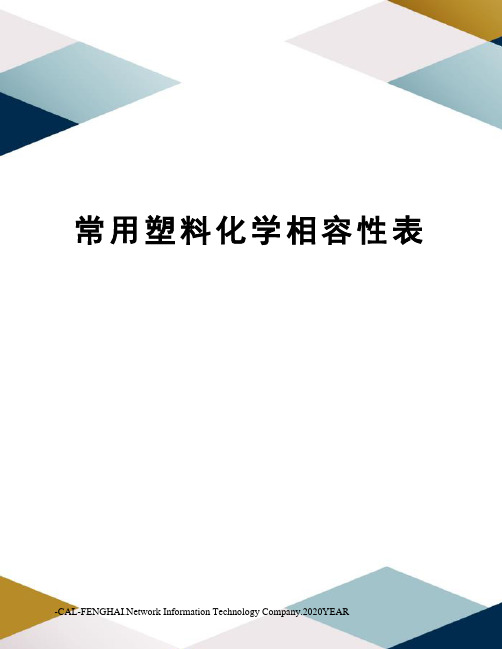
化学相容性 Chemical Compatibility
表格(Form):B
此表仅供指导(This chart is intended only as a guide.)实际使用中可能有变化。如各种化学作用不同,所以不能作到精确保证。
冰醋酸
Acetic acid glacial
R
LR
LR
--
R
NR
NR
R
醋酸纤酯
Cellosolve Acetate
R
R
R
NR
NR
R
醋酸乙酯
Ethyl Acetate
LR
LR
LR
R
R
NR
R
醋酸甲酯
Methyl Acetate
R
LR
NR
R
--
NR
R
醋酸异丙酯
Isopropyl Acetate
R
--
R
R
LR
NR
R
乙醚
Ethyl ether
LR
R
R
R
LR
R
R
R
R
R
NR
R
甲醛40%
Formal dehyde 40%
R
R
R
LR
R
R
R
汽油
Gasoloine
LR
LR
R
LR
NR
R
R
乙烷(无水)
Hexane(dry)
LR
--
LR
LR
NR
R
NR
煤油
Kerosene
R
--
R
企业常用术语
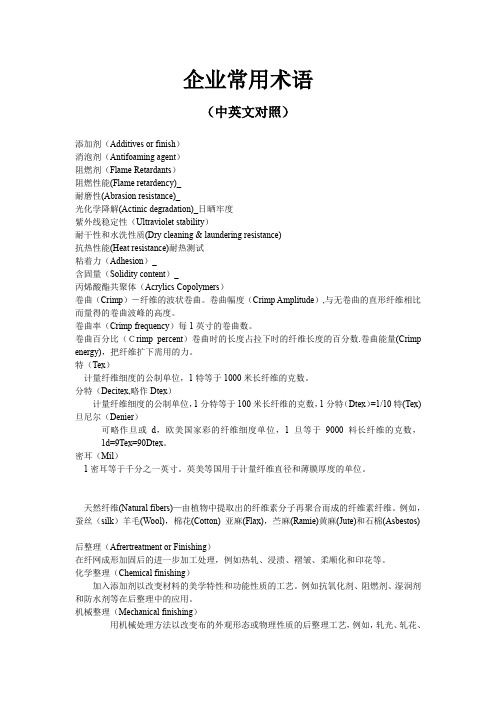
企业常用术语(中英文对照)添加剂(Additives or finish)消泡剂(Antifoaming agent)阻燃剂(Flame Retardants)阻燃性能(Flame retardency)_耐磨性(Abrasion resistance)_光化学降解(Actinic degradation)_日晒牢度紫外线稳定性(Ultraviolet stability)耐干性和水洗性质(Dry cleaning & laundering resistance)抗热性能(Heat resistance)耐热测试粘着力(Adhesion)_含固量(Solidity content)_丙烯酸酯共聚体(Acrylics Copolymers)卷曲(Crimp)-纤维的波状卷曲。
卷曲幅度(Crimp Amplitude),与无卷曲的直形纤维相比而量得的卷曲波峰的高度。
卷曲率(Crimp frequency)每1英寸的卷曲数。
卷曲百分比(Crimp percent)卷曲时的长度占拉下时的纤维长度的百分数.卷曲能量(Crimp energy),把纤维扩下需用的力。
特(Tex)计量纤维细度的公制单位,1特等于1000米长纤维的克数。
分特(Decitex,略作Dtex)计量纤维细度的公制单位,1分特等于100米长纤维的克数,1分特(Dtex)=1/10特(Tex) 旦尼尔(Denier)可略作旦或d,欧美国家彩的纤维细度单位,1旦等于9000料长纤维的克数,1d=9Tex=90Dtex。
密耳(Mil)1密耳等于千分之一英寸。
英美等国用于计量纤维直径和薄膜厚度的单位。
天然纤维(Natural fibers)—由植物中提取出的纤维素分子再聚合而成的纤维素纤维。
例如,蚕丝(silk)羊毛(Wool),棉花(Cotton) 亚麻(Flax),苎麻(Ramie)黄麻(Jute)和石棉(Asbestos)后整理(Afrertreatment or Finishing)在纤网成形加固后的进一步加工处理,例如热轧、浸渍、褶皱、柔顺化和印花等。
SPEARS 中国版《塑料管手册》说明书
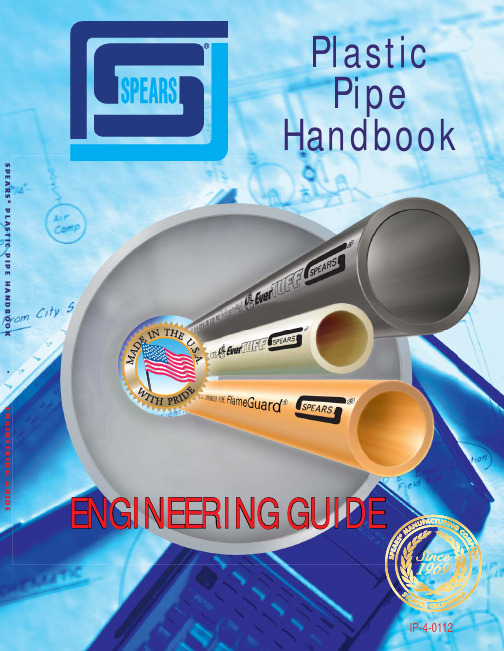
Table of Contents
General Information .........................................................................................................1 Purpose of this Manual..................................................................................................1 Spears® PVC & CPVC Materials ..................................................................................1
Physical Properties of PVC & CPVC Pipe......................................................................2 Dimensions & Pressure Ratings.....................................................................................3
SPEARS® PLASTIC PIPE HANDBOOK
Plastic Pipe
絮凝剂MSDS英文版
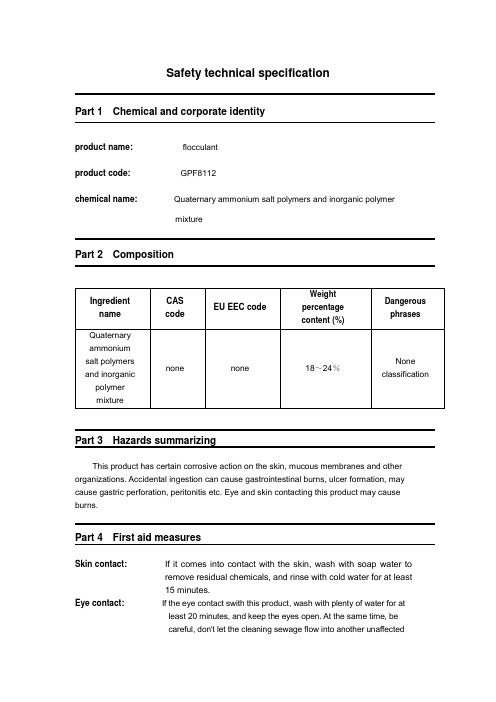
Safety technical specificationPart 1 Chemical and corporate identityproduct name:flocculantproduct code: GPF8112chemical name:Quaternary ammonium salt polymers and inorganic polymermixturePart 2 CompositionPart 3 Hazards summarizingThis product has certain corrosive action on the skin, mucous membranes and other organizations. Accidental ingestion can cause gastrointestinal burns, ulcer formation, may cause gastric perforation, peritonitis etc. Eye and skin contacting this product may cause burns.Part 4 First aid measuresSkin contact: If it comes into contact with the skin, wash with soap water toremove residual chemicals, and rinse with cold water for at least15 minutes.Eye contact: If the eye contact swith this product, wash with plenty of water for atleast 20 minutes, and keep the eyes open. At the same time, becareful, don't let the cleaning sewage flow into another unaffectedeyes. If the stimulus If the stimulus continues and worsens, seekmedical advice immediately.Ingestion: If ingest this product, should drink plenty of water or milk. Don'tflooding vomit. Never put anything else into a comatose man'smouth. Seek immediate medical attention.Inhalation: If inhale this product, move the victim to a place with fresh air. Ifbreathing is difficult, need professionals to give oxygen through a facemask. Seek immediate medical attention.Suggest to doctor: If seek medical advice, show product label to the doctor.Part 5 Firefighting measuresFlammability: won't burnApplicable extinguishant: water mist, dry powderHarmful decomposition product:no abnormal decomposition product or fire dangerPart 6 Leakage emergency treatmentAccording to the Part 8 content, wear appropriate personal protective equipment.Accidental leakage processing method:Use inert substances, such as sand, to cover and absorb the leakage product. Sweep the leakage product including the contaminated soil to a clean and dry plastic container.Please dispose the related wastes in accordance with state and local relevant laws and regulations.Part 7 Handling and storageHandling : Closed operation, local exhaust ventilation. The operator must gothrough specialized training, strict compliance with operatingprocedures. Suggest the operating personnel to wear chemicalsafety goggles, wear rubber acid and alkali resistant clothing,wear rubber acid and alkali resistant gloves. Light loading andlight unloading while carrying the product, prevent damages topackage and containers. Equipped with emergency treatmentequipment for leakage.Storage:When not in use, keep the product in the initial airtight container. Stockin cool, dry, well-ventilated places. Place this product and otherrelated chemicals in the place where the children can not touch. Part 8 Exposure controls/ Personal protectionGeneral principle: Adopting effective overall ventilation equipment in order to make thecontact concentration lowest. Before reuse it, take off thecontaminated clothing, and wash it clean.Personal protectionRespiratory protection: when there is mist emissions, should use the respirator.Skin: wear rubber gloves to process the products, avoid contact with skin.Eyes: when deal with this product, need to wear goggles or safety glasses with side shields. Part 9 Physical and chemical propertiesPhysical state: liquidOdour: mild odourAppearance: non transparent liquidColor: Yellow BrownSolubility in water: completely miscible with waterRelative density: 1.05~ 1.25g/mlPH: 4 ~6(4% solution)Part 10 Stability and reactivityAvoid situation:high temperature, inadequate ventilation, pollutionStability: under normal conditions, the product is stable.Decomposition products:may produce carbon and nitrogen oxides.Taboo items: strong alkaline substances and strong oxidizing agent substancesPart 11 Toxicology informationThis product is not included in the carcinogenic substances.Part 12 Ecological informationThis product may have some toxic effect on fish and aquatic organism.Avoid this product to enter the waterway and water area.Part 13 Waste disposalWaste disposal notice: Don't pour this product, leakage products, containers with full ofthis product or part of this product into the trash. It will causereactions when contacting with taboo substances. Whenabandon waste products no longer use or none contaminatedproducts, please dispose them according to the state or localregulations requirement.Empty containers disposal: It is not allowed to re-use the product packaging container. Thoroughly flush it clean before abandoning it as a waste.Part 14 Transport informationUN number: --Risk classification: non-dangerous goodsPackaging categories: plastic packagingDangerous goods ID: noClassification: None classificationPart 15 Regulatory informationPart 16 Other informationMSDS print date:: November 18, 2007MSDS release date: December 18, 2007Version number: First EditionStatement: the information is based on our current knowledge, however, this does not constitute guarantee of any specific product characteristics and does not establish a legally valid contract relationship.。
ISO 14419-2010 纺织品 耐碳氢化合物测试-拒油测试

Reference numberISO 14419:2010(E)© ISO 2010INTERNATIONALSTANDARD ISO 14419Second edition2010-03-01Textiles — Oil repellency — Hydrocarbonresistance testTextiles — Oléofugation — Essai de résistance aux hydrocarburesISO 14419:2010(E) PDF disclaimerThis PDF file may contain embedded typefaces. In accordance with Adobe's licensing policy, this file may be printed or viewed butshall not be edited unless the typefaces which are embedded are licensed to and installed on the computer performing the editing. Indownloading this file, parties accept therein the responsibility of not infringing Adobe's licensing policy. The ISO Central Secretariataccepts no liability in this area.Adobe is a trademark of Adobe Systems Incorporated.Details of the software products used to create this PDF file can be found in the General Info relative to the file; the PDF-creationparameters were optimized for printing. Every care has been taken to ensure that the file is suitable for use by ISO member bodies. Inthe unlikely event that a problem relating to it is found, please inform the Central Secretariat at the address given below.COPYRIGHT PROTECTED DOCUMENT© ISO 2010All rights reserved. Unless otherwise specified, no part of this publication may be reproduced or utilized in any form or by any means,electronic or mechanical, including photocopying and microfilm, without permission in writing from either ISO at the address below orISO's member body in the country of the requester.ISO copyright officeCase postale 56 • CH-1211 Geneva 20Tel. + 41 22 749 01 11Fax + 41 22 749 09 47E-mail copyright@Web Published in Switzerlandii© ISO 2010 – All rights reservedISO 14419:2010(E)Contents PageForeword (iv)1Scope (1)2Normative references (1)3Terms and definitions (1)4Principle (2)5Safety precautions (2)6Reagents (2)7Apparatus (3)8Test specimens (3)9Procedure (3)10Evaluation (4)11Evaluation of results (4)12Test report (5)Annex A (informative) Precision and bias statement (6)Bibliography (7)--```,`,``,`,,,``,`,,,``,,`,,,,`-`-`,,`,,`,`,,`---© ISO 2010 – All rights reserved iiiISO 14419:2010(E)iv© ISO 2010 – All rights reservedForewordISO (the International Organization for Standardization) is a worldwide federation of national standards bodies(ISO member bodies). The work of preparing International Standards is normally carried out through ISOtechnical committees. Each member body interested in a subject for which a technical committee has beenestablished has the right to be represented on that committee. International organizations, governmental andnon-governmental, in liaison with ISO, also take part in the work. ISO collaborates closely with theInternational Electrotechnical Commission (IEC) on all matters of electrotechnical standardization.International Standards are drafted in accordance with the rules given in the ISO/IEC Directives, Part 2.The main task of technical committees is to prepare International Standards. Draft International Standardsadopted by the technical committees are circulated to the member bodies for voting. Publication as anInternational Standard requires approval by at least 75 % of the member bodies casting a vote.Attention is drawn to the possibility that some of the elements of this document may be the subject of patentrights. ISO shall not be held responsible for identifying any or all such patent rights.ISO 14419 was prepared by Technical Committee ISO/TC 38, Textiles , Subcommittee SC 2, Cleansing,finishing and water resistance tests .This second edition cancels and replaces the first edition (ISO 14419:1998), of which it constitutes a minorrevision. It also incorporates Technical Corrigendum ISO 14419:1998/Cor.1:2004.--```,`,``,`,,,``,`,,,``,,`,INTERNATIONAL STANDARD ISO 14419:2010(E)© ISO 2010 – All rights reserved 1Textiles — Oil repellency — Hydrocarbon resistance test1 ScopeThis International Standard is applicable to the evaluation of a substrate's resistance to absorption of aselected series of liquid hydrocarbons of different surface tensions.This International Standard is intended to provide a guide to oil stain resistance. It can provide a rough indexof oil stain resistance as, generally, the higher the oil repellency grade, the better resistance to staining by oilymaterials, especially liquid oil substances. This is particularly true when comparing various finishes for a givensubstrate. This International Standard can also be utilized in determining if washing and/or drycleaningtreatments have any adverse effect on the oil repellency characteristics of a substrate.NOTE 1 Washing and drycleaning treatment procedures are described in ISO 6330 or ISO 3175 (all parts),respectively.This International Standard is not intended to give an absolute measure of the resistance of the substrate tostaining by all oily materials. Other factors, such as composition and viscosity of the oily substances, substrateconstruction, fibre type, dyes and other finishing agents, also influence stain resistance. This InternationalStandard is not intended to estimate the resistance to penetration of the substrate by oil-based chemicals.NOTE 2 For the evaluation of the resistance to penetration of the substrate by oil-based chemicals, see ISO 6530.2 Normative referencesThe following referenced documents are indispensable for the application of this document. For datedreferences, only the edition cited applies. For undated references, the latest edition of the referenceddocument (including any amendments) applies.ISO 139, Textiles — Standard atmospheres for conditioning and testing3 Terms and definitionsFor the purposes of this document, the following terms and definitions apply.3.1gradesymbol for any step of a multistep standard reference scale for a quality characteristicNOTE The grade is assigned to test specimens exhibiting a degree of the quality comparable to that step of thestandard reference scale. 3.2oil repellency characteristic of a fabric whereby it resists absorption of oily liquids--```,`,``,`,,,``,`,,,``,,`,,,,`-`-`,,`,,`,`,,`---ISO 14419:2010(E)2© ISO 2010 – All rights reserved4 PrincipleDrops of standard test liquids, consisting of a selected series of hydrocarbons with different surface tensions,are placed on the substrate surface and then observed for absorption, wicking and contact angle. The oilrepellency grade is the highest numbered test liquid which is not absorbed by the substrate surface.5 Safety precautionsSAFETY PRECAUTIONS — These safety precautions are for information purposes only. Theprecautions are ancillary to the testing procedures and are not intended to be all inclusive. It is theuser's responsibility to use safe and proper techniques in handling materials in this InternationalStandard. Manufacturers should be consulted for specific detail such as material safety data sheetsand other manufacturer's recommendations.5.1 Good laboratory practices should be followed. Wear safety glasses and impervious gloves whenhandling test liquids in all laboratory areas.5.2 Some of the hydrocarbons specified in this International Standard are flammable. Keep away from heat,sparks and open flame. Use with adequate ventilation. Avoid prolonged breathing of vapour or contact withskin. Do not take internally.6 ReagentsAll reagents shall be of a suitable analytical grade. Ensure the standard test liquids are used and stored at atemperature of (20 ± 2) °C. All reagents and standard test liquids have a maximum shelf life of three years.6.1 Test liquids , prepared and numbered according to Table 1.The purity of test liquids affects surface tension of the liquid. Use only analytical grades of test liquids.6.2 White mineral oil , USP white mineral oil 340-355 SSU at 37,8 °C with Saybolt colour +30. Table 1 — Standard test liquids CompositionOil test liquid number Density Surface tensionkg/l N/m at 25 °C None (fails with white mineral oil)0 — — White mineral oil1 0,84 – 0,87 0,031 5 65:35 white mineral oil: n -hexadecane by volume2 0,82 0,029 6n -hexadecane 3 0,77 0,027 3 n -tetradecane 4 0,76 0,026 4 n -dodecane 5 0,75 0,024 7 n -decane 6 0,73 0,023 5 n -octane 7 0,70 0,021 4 n -heptane 8 0,69 0,019 8--```,`,``,`,,,``,`,,,``,,`,,,,`-`-`,,`,,`,`,,`---ISO 14419:2010(E)© ISO 2010 – All rights reserved 37 Apparatus7.1 Dropping bottles , each marked with the appropriate oil test liquid number, to which, for convenience, it is desirable to transfer the test liquids from stock solutions. A typical system found useful consists of 60 ml dropping bottles with ground-in pipettes and neoprene bulbs. Prior to use, the bulbs should be soaked in heptane for several hours and then rinsed in fresh heptane to remove soluble substances. It has been found helpful to place the test liquids in sequential order on a wooden platform on the grading table.7.2 White textile blotting paper , of approximately (0,71 ± 0,1) mm in thickness, weight of (370 ± 5 %) g/m 2 and an absorbent capacity of (220 ± 30) %.1)7.3 Laboratory gloves of general purpose are sufficient.8 Test specimensThree test specimens of approximately 20 cm ¥ 20 cm are needed. Test specimen size should be chosen to represent all physical and colour characteristics of the fabric and allow ample room for testing. Condition the test specimens for a minimum of 4 h at (20 ± 2) °C and (65 ± 4) % RH prior to testing. See ISO 139. 9 Procedure9.1 Place the first test specimen flat on the white textile blotting paper (7.2) on a smooth, horizontal surface with the face side on top. Testing should be conducted in standard atmosphere for testing in accordance with ISO 139. Testing should be completed within 30 min, if test specimens are removed from a conditioning chamber.9.1.1 When evaluating open-weave or “thin” substrates, place the test specimen on at least two layers of the substrate; otherwise, the test liquid can wet the underlying surface, not the actual test substrate, and thereby cause confusion in the reading of the results.9.1.2 Equipment, benches and gloves should be free of silicone. Use of silicone-containing products could adversely affect oil repellency grades.9.2 Wearing clean laboratory gloves (7.3), brush the pile of napped or pile substrates using the hand, in the direction giving the greatest lay of the surface prior to placing the drops of the test liquid. (The direction giving the lowest pile.)9.3 Beginning with the lowest-numbered test liquid (oil test liquid No. 1), carefully place small drops (approximately 5 mm in diameter or 0,05 ml volume) on the test specimen in a minimum of five locations representing all physical and colour characteristics of the fabric. The drops should be approximately 4,0 cm apart. The dropper tip should be held at a height of approximately 0,6 cm from the substrate surface while placing drops. Do not touch the substrate with the dropper tip. Observe the drops for (30 ± 2) s from approximately a 45° angle. Assess each drop in accordance with Figure 1. Immediately examine the reverse of the fabric for any wetting.1) White Textile Blotting Paper is the trade name of a product supplied by the American Association of Textile Chemists and Colorists (AATCC), P.O. Box 12215, Research Triangle Park, NC 27709-2215. This information is given for the convenience of users of this International Standard and does not constitute an endorsement by ISO of the product named. Equivalent products may be used if they can be shown to lead to the same results.--```,`,``,`,,,``,`,,,``,,`,,,,`-`-`,,`,,`,`,,`---ISO 14419:2010(E)9.4 If no penetration or wetting of the substrate at the liquid–substrate interface and also no wicking around the drops occur, place drops of the next high-numbered test liquid at an adjacent site on the substrate so as not to interfere with the previous test and again observe for (30 ± 2) s. Assess each drop in accordance with Figure 1. Immediately examine the reverse of the fabric for any wetting.9.5 Continue this procedure until one of the test liquids shows obvious wetting or wicking of the substrate under or around the drop within (30 ± 2) s. A maximum of six tests (oil test liquids) may be performed on one test specimen.9.6 Repeat the procedure with the second sample. A third sample may be required (see Clause 11).10 Evaluation10.1 The oil repellency grade of a substrate is the numerical value of the highest-numbered test liquid which will not wet the substrate within a period of (30 ± 2) s. A grade of zero (0) is assigned when the substrate fails the white mineral oil liquid test. Wetting of the substrate is normally evidenced by a darkening (greying/shadowing) of the substrate at the liquid–substrate interface or wicking and/or loss of contact angle of the drop. On black or dark substrates, wetting can be detected by loss of “sparkle” within the drop.10.2 Different types of wetting may be encountered depending on the finish, fibre, construction, etc.; and the determination of the end point can be difficult on certain substrates. Many substrates show complete resistance to wetting by a given test liquid [as indicated by a clear drop with a high contact angle (see Figure 1, Example A)], followed by immediate penetration by the next higher-numbered test liquid. In these instances, the end point and oil repellency grade are obvious. However, some substrates show progressive wetting under several test liquids as evidenced by a partial darkening of the substrate at the liquid–substrate interface (see Figure 1, Examples B, C and D). For such substrates, the point of failure is considered to be that test liquid which exhibits complete darkening of the interface or any wicking within (30 ± 2) s.10.3 A failure occurs when three (or more) of the five drops applied from a given test liquid show complete wetting (see Figure 1, Example D) or wicking with loss of contact angle (see Figure 1, Example C). A pass occurs if three (or more) of the five drops applied show a clear, well-rounded appearance with high contact angle (see Figure 1, Example A). The grade is expressed as the value of the pass oil test liquid immediately prior to the fail oil test liquid. A borderline pass occurs if three (or more) of the five drops applied show the rounded drop with partial darkening of the test specimen (see Figure 1, Example B). The grade is expressed to the nearest 0,5 value determined by subtracting one-half from the number of the borderline pass test liquid.11 Evaluation of resultsThe oil repellency grade should be measured on two separate specimens. If the two grades agree, report the value. When the two grades are not in agreement, a third determination should be made. Report the grade of the third determination if that value is the same as either of the first two determinations. When the third determination is different from either of the first two, report the median value. For example, if the first two grades are 3,0 and 4,0 and the third determination is a 4,5 value, report the median value of 4,0. Report the oil repellency grade. This grade variation can be an indication of non-uniform fabric or contamination problems.--```,`,``,`,,,``,`,,,``,,`,,,,`-`-`,,`,,`,`,,`---4 © ISO 2010 – All rights reservedISO 14419:2010(E)© ISO 2010 – All rights reserved 5KeyA passes; clear, well-rounded dropB borderline pass; rounding drop with partial darkeningC fails; wicking apparent and/or complete wettingD fails; complete wettingFigure 1 — Example of assigned grades[Source: American Association of Textile Chemists and Colorists (AATCC)]12 Test reportThe test report shall include the following information:a) reference to this International Standard, i.e. ISO 14419:2010;b) all information necessary to complete identification of the sample tested;c) number of specimens tested;d) conditioning and testing atmosphere used;e) any deviation from the procedure specified;f) test results;g) oil repellency grade.--```,`,``,`,,,``,`,,,``,,`,,,,`-`-`,,`,,`,`,,`---ISO 14419:2010(E)6© ISO 2010 – All rights reserved Annex A(informative)Precision and bias statementA.1 PrecisionA.1.1 Interlaboratory studies were conducted in September 1990 and April 1991 to establish the precision of this test method. The September interlaboratory study involved two participants at each of nine laboratories rating two specimens of each of four fabrics each day for three days. The grades from this study were concentrated into the 1-2 and 4-5 regions of the scale. The April interlaboratory study was conducted with fabrics responding in the 2-3 and 5-7 regions of the scale. This study involved two participants at each of seven laboratories rating two specimens of each of two fabrics each day for two days. (Day interaction was shown not to be a significant factor in the analysis of the September study.) Results from both interlaboratory studies were combined for precision and bias statements. All materials necessary for the studies were provided to each laboratory by AATCC including the standard test liquids. A video recording of the grading procedure prepared at the AATCC Technical Center by the subcommittee and visual examples of pass, borderline and fail conditions were included in the protocol. The fabrics were limited to polyester/cotton materials. The unit of measure was the median of the grades of the two (or three) specimens rated each day.A.1.2 The components of variance as standard deviations of the oil repellency grade were calculated to be as follows:Oil repellency testSingle operator 0,27Between operators/within laboratories0,30Between laboratories 0,39A.1.3 Critical differences: for the components of variance in A.1.2, two observations should be considered significantly different at 95 % probability level, if the difference equals or exceeds the critical differences shown in Table A.1.Table A.1 — Critical differences No. of observations a Single operator Within laboratory Between laboratories1 0,75 1,12 1,552 0,53 0,99 1,453 0,43 0,94 1,42NOTE The critical differences were calculated using t = 1,950 from the Student's t distribution which is based oninfinite degrees of freedom.a An observation is a unit of measure obtained from the median of the grades for 2 (or 3) specimens.A.2 BiasThe true value of the oil repellency grade can only be defined in terms of this test method. Within this limitation, this test method has no known bias.ISO 14419:2010(E)© ISO 2010 – All rights reserved 7Bibliography[1] ISO 3175-1, Textiles — Professional care, drycleaning and wetcleaning of fabrics and garments —Part 1: Assessment of performance after cleaning and finishing[2] ISO 3175-2, Textiles — Professional care, drycleaning and wetcleaning of fabrics and garments —Part 2: Procedure for testing performance when cleaning and finishing using tetrachloroethene[3] ISO 3175-3, Textiles — Professional care, drycleaning and wetcleaning of fabrics and garments —Part 3: Procedure for testing performance when cleaning and finishing using hydrocarbon solvents[4] ISO 3175-4, Textiles — Professional care, drycleaning and wetcleaning of fabrics and garments —Part 4: Procedure for testing performance when cleaning and finishing using simulated wetcleaning[5] ISO 6330, Textiles — Domestic washing and drying procedures for textile testing[6] ISO 6530, Protective clothing — Protection against liquid chemicals — Test method for resistance ofmaterials to penetration by liquids--```,`,``,`,,,``,`,,,``,,`,,,,`-`-`,,`,,`,`,,`---ISO 14419:2010(E)ICS 59.080.01Price based on 7 pages--```,`,``,`,,,``,`,,,``,,`,,,,`-`-`,,`,,`,`,,`---© ISO 2010 – All rights reserved。
- 1、下载文档前请自行甄别文档内容的完整性,平台不提供额外的编辑、内容补充、找答案等附加服务。
- 2、"仅部分预览"的文档,不可在线预览部分如存在完整性等问题,可反馈申请退款(可完整预览的文档不适用该条件!)。
- 3、如文档侵犯您的权益,请联系客服反馈,我们会尽快为您处理(人工客服工作时间:9:00-18:30)。
FLEX 2850
Maximumb, d Temperature
HOMOPOLY M E R
Maximumb, d Temperature
Chemical Substance
Barium Sulfide Beer Beet Sugar Liquors Benzaldehyde Benzene Benzenesulfonic Acid Benzoic Acid Benzoyl Chloride Benzoyl Peroxide Benzyl Alcohol Benzyl Chloride Benzyl Ether Benzylamine Black Liquor Bleaching Agents Borax Boric Acid Boron Trifluoride Brine Brine, acid Brine, basic Brine, chlorinated acid Bromic Acid Bromine dry gas Bromine, liquid Bromine, water Bromobenzene Bromoform m-Bromotoluene Butadiene Butane Butanediol Butyl Acetate Butyl Acrylate Butyl Alcohol sec-Butyl Alcohol t-Butyl Alcohol Butyl Bromide Butyl Chloride Butyl Ether Butyl Mercaptan Butyl Stearate Butylamine sec-Butylamine t-Butylamine 1-Butylene Butylphenol Butyraldehyde Butyric Acid Calcium Acetate Calcium Bisulfate Calcium Bisulfite Calcium Bromide Calcium Carbonate Calcium Chlorate Calcium Chloride Calcium Hydroxide Calcium Hypochlorite Calcium Nitrate Calcium Oxide Calcium Phosphate
CHEMICAL RESISTANCE CHART
Arkema Inc. 2000 Market Street Philadelphia, PA 19103 Tel.: 215-419-7000 CHEM CHART-Rev 04/06
Concentrationa
°F
NRc NR 125 200 200 125 NR NR 100 NR NR 125 125 NR 150 75 150 260 200 125 212 230 230 230 230 2 150 230 230 230 230 170 200 230 230 75 230 230 125 230 100 230 125 230 100 75 75 230 230 230 230 230 230 230
°C
NR NR 50 95 95 50 NR NR 40 NR NR 50 50 NR 65 25 65 125 95 50 100 110 110 110 110 110 110 110 110 NR NR 65 110 65 110 110 110 110 75 95 110 110 25 110 110 50 110 40 110 50 110 40 25 25 110 110 110 110 110 110 110
Aqueous solution or solid Aqueous solution
Aqueous solution or solid Aqueous solution or solid
KYNAR® is a registered trademark of Arkema Inc.
FLEX 2800
10% in water
40% Ethyl Alcohol
Aqueous solution or solid Up to 40% in water Aqueous solution or solid Aqueous solution or solid Aqueous solution or solid
°C
NR 25 50 105 95 65 NR NR 50 50 NR 50 50 NR 120 25 65 140 95 50 100 140 140 140 135 135 135 135 135 NR NR 80 135 65 120 135 135 120 65 105 135 135 25 135 135 50 135 50 135 50 140 40 25 25 135 120 140 140 135 135 140
Concentrationa
°F
230 212 230 NR 170 125 220 170 170 230 230 75 NR 175 230 230 230 75 230 230 230 200 200 125 125 200 150 150 150 230 230 230 NR 100 220 200 200 230 230 NR 230 100 NR NR NR 230 230 125 230 230 230 200 230 230 230 230 230 200 230 230 230
a pure substance unless otherwise indicated. b temperatures in °F have been rounded to °C in 5 degree increments. c NR indicates that KYNAR resin is not recommended for use with the chemical at room temperature or at the temperature indicated. d The temperatures listed are maximum values and do not take into account pressures, vacuums, mixtures, or close tolerances.
°F
NR 75 125 220 200 150 NR NR 125 125 NR 125 125 NR 250 75 150 285 200 125 212 285 285 285 275 275 275 275 275 NR NR 175 275 150 250 275 275 250 150 220 275 275 75 275 275 125 275 125 275 125 285 100 75 75 275 250 285 285 275 275 285
°F
NR NR 125 230 200 125 NR NR 100 100 NR 125 125 NR 170 75 150 275 200 125 212 275 275 275 275 275 275 275 275 NR NR 150 275 150 230 275 275 275 170 200 275 275 75 275 275 125 275 100 275 125 275 100 75 75 275 250 275 275 250 275 275
FLEX 2800
Maximumb, d Temperature
FLEX 2850
Maximumb, d Temperature
HOMOPOLY M E R
Maximumb, d Temperature
Chemical Substance
Acetaldehyde Acetamide Acetic Acid Acetic Acid Acetic Acid Acetic Acid Acetic Anhydride Acetone Acetone Acetonitrile Acetophenone Acetyl Bromide Acetyl Chloride Acetylacetone Acetylene Acrylonitrile Adipic Acid Air Alcoholic Spirits Allyl Alcohol Allyl Chloride Aluminum Acetate Aluminum Bromide Aluminum Chloride Aluminum Fluoride Aluminum Hydroxide Aluminum Nitrate Aluminum Oxychloride Aluminum Sulfate Ammonia, gas Ammonia, Liquid Ammonium Acetate Ammonium Alum Ammonium Bifluoride Ammonium Bromide Ammonium Carbonate Ammonium Chloride Ammonium Dichromate Ammonium Fluoride Ammonium Hydroxide Ammonium Metaphosphate Ammonium Nitrate Ammonium Persulfate Ammonium Phosphate Ammonium Sulfate Ammonium Sulfide Ammonium Thiocyanate Amyl Acetate Amyl Alcohol Sec-Amyl Alcohol Amyl Chloride Aniline Aniline Hydrochloride Aqua Regia Arsenic Acid Asphalt Barium Carbonate Barium Chloride Barium Hydroxide Barium Nitrate Barium Sulfate
°C
NR NR 50 110 95 50 NR NR 40 40 NR 50 50 NR 75 25 65 135 95 50 100 135 135 135 135 135 135 135 135 NR NR 65 135 65 110 135 135 135 75 95 135 135 25 135 135 50 135 40 135 50 135 40 25 25 135 120 135 135 120 135 135
